#And fundamentally neither of them can see the full picture.
Explore tagged Tumblr posts
Text




Why you're nuthin' but a mangy dog and somebody orta shoot you.
#Oklahoma!#Oklahoma musical#Jud Fry#Laurey Williams#Shuler Hensley#Josefina Gabrielle#Oklahoma! musical#Jud x Laurey#Laurey x Jud#oklahomaedit#oklahoma!edit#judfryedit#laureywilliamsedit#pureanonedits#broadwayedit#theateredit#I don't know quite what this is but I'm having feelings about Jud being a dog and about Jud and Laurey and desire.#And how Laurey only sees that Jud wants her physically. That she sees him as much more menacing in that regard her dream than he really is.#And how all he dreams about is her arms around him. Keeping him safe and warm.#Oh he wants her -- no doubt he wants her like that. But it's not just that.#And also that Laurey feels COMPELLED by that in him -- the fact that he wants her. That he's dark and dangerous and a little bit thrilling.#She doesn't want him as a husband but there's something in her that thrills that she can affect a man like that.#And it's how Jud doesn't just want to bed her -- he wants her as his wife. He wants to share a life with her.#But all she can see is that he wants to bed her because he is rough and crude and hard and can't communicate properly to her what he wants.#And he is hurt and damaged and damAGING and his desire for her goes beyond all bounds -- so she is justifiably scared by it and him.#And fundamentally neither of them can see the full picture.#They're both so -- so so so so so I'm so fascinated by their relationship.
29 notes
·
View notes
Note
So after thinking about it for a good nine minutes at work today and after just watching The Indecisive King, I’ve decided the crown Aka the Relic of Choice is IN the tree. I am not good at long theories but come ON the first king making decision he did was about a Tree That Fell (and broke a fence). It’s a relic that has no practical use, meaning that Oz putting it in the Ever After means he would’ve had no use for it himself. I don’t know about the sword but the lamp can only answer 3 questions every 100 years and the staff can only make and keep one new creation at a time and it destroys the last thing it makes to create a new one. ALSO I guess the moral or good end of The Indecisive King is that one person having to carry the burden of making all the rules and knowing too much on their own leads to that person being burnt out and second guessing themselves. I still have no idea what’s really going on with Alyx and what truly happened to her both the first time and then with Jaune, but we don’t have the full picture. “Share your burden with me. Let me wear the crown so I may understand.”
“This crown… it gives a glimpse into the future, to a decision that must some day be made.”
“If you only concern yourself with the future you will miss the good things right in front of your eyes. Life is full of decisions, but you must trust yourself to do the right thing when the time comes. YOU must keep living.”
They don’t know how to stop Salem, they don’t know what’s waiting for them back home, they don’t know if they can do all they’ve been asked to do. But the point is that none of them are doing it alone. None of them have All the answers but Together they might just find one. If there IS a sacrifice that’s a choice they’ll have to make. And if not there’s probably going to be one last little mind puzzle they have to answer for themselves before the path home is revealed. We know the sword is in Vacuo. If the crown really is at the ruins then things will end where they started which is at Beacon which is what I personally would like, for them to go back to Beacon I mean. But the crown has a very good chance of being in the Ever After and I’m on team tree until the next four episodes prove me wrong haha
Also the cat endlessly seeking knowledge via all their questions and the opening of the story which is “Is knowledge the answer to all your problems? Surely being more informed leads to smarter choices.” Idk it’s giving the gang isn’t asking the right or interesting questions bc they’ve been trying to stick to a path that fundamentally will not work for them by virtue them not being in the Book but the Location of the Ever After and their very presence would’ve changed things even if they were in the literal book.
Team Tree!
you know. i could see it. i mean it depends if ozma knows about the ever after and how to get there (i don't think he would leave the crown in the ever after without ever having a way to get it back).
alternatively it could be that the door that leads to remnant (if such door actually exists) is somehow connected to where the crown is, so the crown would still be on remnant, but in a place that would still have (magical) protection as i doubt the other side of the door to the ever after is just. out there for everyone to walk through.
main reasons i find this compelling is bc of 1. the connection between choice and knowledge, 2. the ever after is definitely playing around with these two concepts, with the curious cat asking questions (and answering them, and also highlighting the importance of asking the right questions) and the whole thing with the crossroads that requires making choices between two options (but is that the only way to go through it? deciding to go with neither is a choice as well.) and 3. well.. there's is a big tree in the ever after, and the vault of knowledge also had a tree with some magical properties. like. the trees, i do not understand them, but they do compel me so.
there's also the "a place like these vaults" instruction team rwby gave ambrosius for the central platform, from where they then fell to the ever after, so. the possibility is there that the vaults are connected to the ever after in some way—if not directly, then like. being in the same realm or something. perhaps acting as in-between? the vaults have similar effects within them as did the white void where the god of light brought ozma from afterlife.
i think there's a good possibility that there's something here, but how exactly it all fits together, i'm still unsure about.
#rwby#rwby9#rwby spoilers#majoringinsarcasm#ask.strqyr#it's a nice and thought provoking theory#like i could subscribe to this
29 notes
·
View notes
Note
What did you think about Adam apparently trying to talk himself out of being in love with Ronan when he went home to st Agnes every night?? It sounded so prosey but it didn’t feel like it was supported by the text? Like I felt the Opal story and CDTH did nothing to indicate that
omg sorry i only just saw this q !! but yeah idk i’ve been thinking a lot about that recently. i think with certain contexts it does make some sense to me? not that adam would want to stop loving ronan but that he’d feel like he should stop loving him. that ending things sooner rather than later felt like the safer thing to do for both of them, emotionally speaking. having said that, i feel like if we’d been in adam’s head at all through trkopal or dreamer trilogy, it would’ve made this information less surprising (another loss for the adam pov agenda rip). i have a lot of thoughts on this tho and i ended up writing a lot more than i intended to so i’m going to get into it under the cut !
ok so first off, i think in terms of adam’s arc in dreamer trilogy (or what we saw of it lol) it would make a lot more obvious sense for him to be having that dilemma. at that point he’s actually living in this version of himself that can’t coexist with the version of him who chose a life with ronan. it did kind of surprise me that he’d been feeling that way in the opal story, but then again that story was only told through opals eyes so we only really got bits and pieces of the full picture. we weren’t in adam or ronan’s heads. i think it’s kind of interesting that maggie went back to it from a sort of omniscient point of view in greywaren tho — she tends to do that a lot, like retrospectively add new context to previous scenes by changing perspectives. i guess a perk of writing multiple points of view is that you get a novel filled with unreliable narrators, which means you can withhold information from readers by having characters misread or ignore certain aspects of a situation.
going back to what you said tho i feel like some people would read that section you mentioned and take it to mean that he was going back on his conversation with gansey in trk or that he didn’t want to be with ronan. i don’t think that’s it at all - i think he saw that they were heading towards a future that couldn’t hold their relationship without either of them having to compromise some fundamental part of their lives. and these were compromises that neither of them could make or would let the other make. it was also a conversation they weren’t having; we know they weren’t properly communicating at that point, not in the way they perhaps should’ve been given their situation. but it’s also heavily implied that the reason they weren’t voicing their concerns was because they both knew they wouldn’t be able to fix these problems by just voicing them. they were going to go in circles: adam didn’t want to do long distance; ronan couldn’t move to boston; adam could go to a closer school but ronan would never let him do that.
i think it’s also important to note that they were both at a crossroads in their lives that summer. they’d survived past the point where they thought they would, and now the things they thought they wanted in life were starting to feel different to them. everything was going to shift when adam moved away. they both knew something about their situation had to change but neither of them were ready or able to make it happen. and so they spent a blissful summer trying to avoid confronting it, because it hurt too much to admit that it all felt impossible.
i think we should also remember that we didn’t have any povs from adam in dreamer trilogy OR the opal story. every time we saw the pair of them interacting in dreamer trilogy it was through ronan, who was absolutely in denial about how hard it was going to be for them (see: his theory of plausible deniability at the beginning of cdth). we have to base our understanding of adam’s behaviour on outside observations of him. ronan’s pov in cdth does mention how tumultuous adam’s mental state had been during that summer, especially when he found out he was accepted at harvard. he was anxious about starting something he’d been working towards for years, and he was anxious about leaving ronan and having to deal with the reality of their relationship outside of the barns. it makes sense that adam, who is generally less in denial about harsh realities than ronan, was probably having a silent dilemma over it. he’s an incredibly practical character, he over-analyses everything, there’s not a single outcome of a situation that he wouldn’t consider. there was no way that he hadn’t at least touched on the possibility of having to end things with ronan, however painful that outcome is. he was probably debating whether it was worth dragging themselves through something that was inevitably going to hurt them, or if it would just be easier to confront it head on. it’s one of those things that sometimes happens in relationships where, yes, the love between the two people is strong and present, but the love isn’t the problem. it’s their circumstances. sometimes you can’t see a way to fit your life and your relationship together, sometimes you can’t find a compromise that works, and i think that’s what adam was afraid of. he associated ronan with the magic part of his life. in his mind, magic and harvard couldn’t coexist.
the problem adam clearly had was that while this self-preserving and practical side of him was trying to reason it out (i.e. if you convince yourself you don’t love someone then you save yourself the pain of losing them), the more emotional side of him couldn’t fathom not loving ronan. as soon as he was with ronan again, the reality of loving him was too tangible. which also fits into why it feels slightly surprising to learn this information: we pretty much only saw adam when he was with ronan in trkopal, and (as we now know) every time he was with ronan he forgot everything he’d been telling himself when alone. it became impossible for him to imagine ever throwing their relationship away for anything. i also think that’s why that line is so sad. ronan meant so much to him that adam couldn’t convince himself to step away and save his heart from further pain.
and then we have ronan. he’d essentially been having the same dilemma over their situation as adam. distance from someone makes it easy to convince yourself that things won’t work out. isolation and distance makes it even easier. which is why (amongst other factors) it reached a point in book 2 where ronan, more isolated and distanced than ever, ended up being the one to call it. because ronan sees things in black and white and adam tends to focus on the grey areas. because ronan is driven by impulse and adam is driven by considered decisions. because at that time, ronan couldn’t exist in multiples; he was already being pulled in so many directions by his human side and his magic side. he didn’t know how to exist as both: as soon as one thread from his human life came loose, he was unable to contain the rest. adam, however, has always existed in multiples. student and logician, man and boy, etc. his life is a balancing act. he’d balanced friends and school and magic and work and an abusive home life; he could balance this too. he could hold on to this. to quote adam himself, he wanted it too much. even after ronan had essentially ended things between them, adam still found somewhere safe for ronan’s body, still came back to visit him, still risked his life scrying in order to find him. it’s like adam said in greywaren, ronan was where he stored all the reality. with the direction he was going in his life at that point, if he lost ronan, he was losing the one person who knew the truest version of him — he’d essentially end up losing himself fully.
so yes. i think considering everything, it does make sense to me that adam had that dilemma because it fits with the way he behaved in dreamer trilogy. it also feels very realistic. everyone has doubts, or considers cutting loose to avoid the risk of heartbreak. i think it’s quite an accurate depiction of how a lot of people behave and feel in relationships, especially when it’s your first long-term relationship, and especially when you were never taught how to properly and healthily communicate (which neither of them were). it’s hard to imagine a way out of the problems you’re facing, especially when those problems feel out of your control. but i think for me it only solidified how strongly adam felt for ronan, because even with those fears and those doubts he was never going to walk away. no matter how much easier it may have felt to do so, he always came back.
#ask#doughfaceddcpig#greywaren spoilers#adam parrish#pynch#this is quite long sorry 😵💫 i went on a slight tangent but i had a lot of thoughts!
81 notes
·
View notes
Text
Camila Noceda and Flawed Parenting
A perspective by a flawed person with loving but extremely flawed parents
I’m genuinely baffled at some people’s hostile reaction towards Camila. Like… do any of you have flawless parents that always know the best solution instantly, make no mistakes and never get emotional?
My parents are great. They’re super supportive and I love them very, very much. Overall I think I got very lucky in the parents department.
But god, they are far from flawless. I still live at home, and despite all the good, there’s moments when I can’t take my dad anymore. He’s the kind of dad that stayed up until two am to help me with homework when I was in school, and he does so, so many things to make sure I’m happy. I know that. But despite all of this, I have told my mom in emotional moments before that I’m not sure if I can keep living with him, because for all his good sides, he has a couple of fatal flaws that sometimes make him unbearable.
My mom listens to me and is very open to being educated on certain topics, but she has her flaws, too. She hates when I fight with my dad, and gets so torn up about it that I’ve once apologized to my dad out of fear of her getting into a car crash otherwise. She’s very vocal about certain flaws of mine, and sometimes uses the things she does for me as leverage against me when she gets very emotional.
And both of my parents pay a lot more attention to my brother because he needs it more, because he’s more of a ���problem child” while I “seem so capable” even when I’m not.
And guess what? I’m not a perfect child. I make mistakes sometimes, some of them pretty severe. Just like Luz, I’m the kind of person that struggles to communicate certain issues of mine to her parents. I’m stubborn, and when I get emotional, I say very hurtful things sometimes. So do they.
And this has nothing to do with my parents being horrible or abusive. They’re neither of those things.
The takeaway from this should not be that my entire family is made up of terrible people, but that we’re all flawed in our own ways, despite loving each other and trying our best. There’s things about my parents I wish I could change, and there are things about me that my parents wish they could change. And to an extent, that’s perfectly normal.
In our strengths and flaws and frustration with each other, we’re all human.
Specific, spoiler-y Camila and Luz things under the cut since this got very long.
We have no indication that Camila has a pattern of emotionally manipulating Luz. Her “emotional manipulation” as I’ve seen some people put it, is people for some reason thinking that the second you become an adult, you’re suddenly perfect and can no longer make mistakes, lest you’ll be dubbed horrible and abusive.
The whole concept is absurd to me. There is no perfect way to parent. There simply isn’t. Of course, there’s some genuinely abusive patterns that are horrible and inexcusable. But out of the parenting styles that aren’t, which one works depends on a number of factors, one of which absolutely includes that every child is different and has different needs. Camila is an amazing parent for Vee, giving the kid everything she’s ever longed for. She’s not an ideal parent for Luz. And that’s because Luz and Vee have fundamentally different needs.
Likewise, Luz is a pretty great child for Eda, but not a perfect fit for Camila. Luz relates to Eda a lot more than she relates to her mom, and that’s why the two of them have an easier time understanding each other. Both of these mother-child relationships exist, and one is not more doomed to fail than the other, but I think you’ll agree that the better you understand someone and where they’re coming from, the easier it is to communicate, pick up on certain signs, etc.
As mom and daughter, Camila and Luz are both flawed and have issues seeing the other’s perspective because of how different they are. And we should simultaneously acknowledge both of their roles in the issue and give both of them the space to learn and grow past those issues.
Luz struggles to communicate her problems. She doesn’t want to burden people in the demon realm, and it’s a given that this started out as not wanting to burden her mom. So she keeps quiet about her issues. Camila tries hard but can’t read her daughter’s mind, so there’s only so much she can do to understand and help the way Luz needs her to. Hell, Eda, who Luz is a lot more open with than her mom, struggles to help her, because Luz doesn’t tell her what’s wrong. I don’t see anyone calling Eda a terrible mom for that.
Camila tries her best, but she struggles to understand her daughter because of this, and because of how fundamentally different they are. She loves Luz’s creativity, we actively see her supporting it in the new episode—she keeps the weird stuff Luz made because she thinks Luz will regret throwing it away, and even plays along in what she assumes to be some elaborate role play because “she’s glad Luz kept her creativity even though it’s not made things easy for her at school”. But at the beginning of the show, said creativity got out of hand and people got hurt. Luz could’ve gotten hurt. So of course Camila had to interfere. I love Luz dearly, but she thought it was okay to bring snakes to school and set off fireworks inside a school building. Creativity is great. Doing reckless stuff that causes people to get hurt is not.
In sending Luz to camp, Camila tried to have someone else fix her issue because she didn’t know how to help Luz. That was a mistake, and a bad one at that, but she’s realizing that. She looks disheartened when Vee tries to throw out Luz’s stuff, because she never meant to change her daughter or take that part of her away. She just thought Luz needed a reality check—which, for the record, is something the narrative actually agrees with.
Luz spends her time in the demon realm getting reality check after reality check, realizing that even her ideal fantasy world where she has everything she always wanted doesn’t mean she’s free of consequences. She goes overboard constantly, causing:
-Eda to be forced to fly into a trap because Luz is chasing a fantasy (Witches before Wizards)
-Eda to almost be branded by her sister because Luz doesn’t think through why Eda doesn’t use magic to publicly announce her presence constantly (Once Upon a Swap)
-Eda and the twins to get kidnapped by a Slitherbeast because Luz stole Amity’s wand (Adventures in the Elements)
-Her friends to get hurt when she goes overboard trying to help Willow (Wing it like Witches)
-Eda to be captured and almost petrified because Luz thought she could just steal from the Emperor with no consequences in an attempt to help (Agony of a Witch)
I’m like 90% sure these aren’t even all. None of those make her a terrible person, for the record, but as all humans are, she is flawed and makes bad choices. She learns from these experiences and matures, just like her mom had hoped she would at camp. She’s also made friends there, which was another thing Camila wanted for her daughter.
You’ll probably realize that a lot of Luz’s behaviors I mentioned follow one of two patterns: 1. Luz’s idealized fantasy world causing problems, when she walks around with rose tinted glasses and gets people in trouble in the process because she hasn’t thought about the consequences, and 2. Luz trying to help someone she loves, but instead making things worse in the progress. The issue with this one is often that she doesn’t communicate her ideas/listen to the people she’s trying to help—like when Willow and Gus said they’ve had enough of Grudgby, or how she never actually talks to Eda about the healing hat idea before doing something reckless.
…does the latter one sound familiar to you at all? No? Because it’s the exact same thing that Camila did.
Some of the things Luz does are reckless and actively endanger others and herself, and that’s something that I think we need to acknowledge before judging Camila. As Luz’s mom, it’s Camila’s job to interfere in those situations. That she made a mistake while trying to protect Luz doesn’t make her a terrible person, especially as, again, the narrative proves her right to an extent.
I’m not saying her making Luz promise to come back and stay isn’t something that hurt Luz—it absolutely is. But it was born out of desperation. She’s emotional and in shock. She’s so full of pain and regret. She just wants her fourteen year old daughter home safe, and there’s nothing abusive or even morally ambiguous about that.
From Luz’s perspective, what she says is absolutely heartbreaking, but from Camila’s, it’s perfectly reasonable. I doubt Camila has the full picture, but even if she does, she’s had a full fifteen seconds to process that her daughter has not only been lying to her for months, but chose to leave her, and is in the demon realm of all places. Of course she’d be emotional and upset about that! Who wouldn’t? Camila isn’t a robot. If she’d been calm about this I’d be way more concerned, honestly.
My parents don’t get mad that easily, but if I would lie to them for weeks on end, they’d be pissed off too, not even taking the running away from home part into account. That’s a normal thing. People don’t like being lied to. Camila is absolutely devastated in that moment because she’s scared that Luz left because she hates her, when Luz actively states that her leaving wasn’t about her mom—which is another thing we should really be acknowledging.
Abusive parents suck and abuse should obviously never be apologized or trivialized, but saying something hurtful in the heat of the moment isn’t the same thing as being an abusive parent. My parents have done this. I’ve done this. And yes, those things can be emotionally manipulative, but there’s a huge difference in whether that’s a habit or a person speaking out of hurt and desperation in a very specific context. I doubt there’s anyone on the entire planet that hasn’t had a bad moment where they’ve said something like this because they were hurting. People lash out when they hurt, and they beg for reassurance when they’re scared. That’s something we all do.
The whole mindset of “all parents have to be perfect and can never get upset or make any mistakes” is harmful as hell, and honestly also very unrealistic. No parent is perfect, and especially people like me who have a relationship with their parents that’s very good overall should know that.
Once you have a child, parenting is a non-stop learning process, every day for the rest of your life. Taking away that room to grow and expecting perfection isn’t helping anyone, especially not struggling single parents.
And I see Camila as someone who is very willing to learn, because at the end of the day, all she wants is for Luz to be happy. Let’s give her some time to wrap her head around this whole situation. Let’s see what she says once she sees for herself how happy Luz is in that world, may it be via the videos eventually coming through or Camila visiting and meeting Luz’s found family, her friends and her girlfriend.
Ultimately, I don’t think Camila will force Luz to stay at home, but we have to give her some time. She wants what’s best for Luz, and she’s gonna need some convincing that a dangerous magical world is what’s best. I feel like that’s very normal considering the circumstances.
Her and Luz need to work on their communication on both ends, they both have things to learn, but I’m certain they’ll manage to fix their relationship in the long run.
If the bunk bed is any indication, I think Vee is gonna stay in the human realm permanently while Luz sleeps at home but keeps attending Hexside in the daytime. That feels like a solution that keeps everyone happy, and allows Luz to spend time with all the people she loves. I can’t see her being forced to choose at the end.
As a closing statement: Eda isn’t an ideal mom, Amity isn’t an ideal friend or girlfriend and neither is Luz, Lilith isn’t an ideal sister… but that’s because no one is ever an ideal anything. Being flawed is a big part of being human. Everyone has different facets to their personality. Their flaws are what makes them such great, relatable, believable characters.
And I feel the same way about Camila. She’s an extremely believable character that reminds me of my own parents, flawed but very loving nonetheless.
(Also honestly, I think it’s pretty telling that some of you guys immediately bash the black single mom that’s obviously trying her hardest while giving the benefit of the doubt to Alador, who has been portrayed as neglecting and threatened his six year old daughter on screen. This was already a thing before we knew much about either of them, and I’m disappointed but unfortunately not very surprised that it still is.)
#the owl house#toh#lumity#luz noceda#Camila noceda#Camila the owl house#toh spoilers#owl house#Camila toh#toh meta#eda clawthorne#luz x amity#eleena rants#noceda family#yesterday’s lie#toh season two#the owl house season two#Vee Noceda#spoilers#owl house spoilers#the owl house spoilers#luz toh#luz the owl house#toh Camila#character flaws#long post#spoilers under cut#Personal
979 notes
·
View notes
Note
What happened w the rationalist community, if you’re ok talking about it?
LONG REPLY TIME.
In my Wild Youth (tm) I was hardcore in the rationalist/skeptic/humanist community. You know, the New Atheist types (the vast majority of the community didn’t call themselves New Atheists, that was mostly American Dawkins fans, but we were those kinds of people, just less arrogant-PR about it). For people who don’t know, the core philosophy of this subculture basically comes down to: - humans are mostly good people, or try to be good people, and we should act in ways that are good for humanity, the environment, etc. - people with better or more accurate information about the world are capable of making better decisions - it is therefore vitally important that we view the world as accurately as possible. Truth is inherently important and valuable. We should do everything we can to make sure that our beliefs about the world are as accurate as possible. - your mind will lie to you. Cognitive biases have their social and evolutionary uses, but they result in bigotry and bad information. We should do everything we can to identify and compensate for these, and think as rationally as a human is capable of. - while it’s not perfect, science is the most effective tool we have for determining what is most likely to be true. Rationalism is therefore massively pro-science and pro-science education. (This isn’t a blind trust; most hardcore rationalists are scientists and fully aware of the limitations of the messy reality of how science is funded and published and the biases that introduces. These are taken into account. The other hardcore rationalists tend to be magicians/illusionists.)
All of this is perfectly fine and a hill I’m still perfectly willing to die on.
When you get a bunch of people together who are sincerely seeking truth and want the world to be a better place, there are some fairly obvious groups that they’re going to tangle with. Before my time, when we were just called skeptics, the main targets had been psychics and life-after-death spirit-communing con artists (this is where our magicians came from, the philosophical descendants of Houdini, one of the earliest voices in the movement, and later James Randi). But the big proponents of harm in my time were the healing crystals/essential oils/faith healing people, and the ‘Creation should be taught instead of evolution’ creationists. We spent a lot of time trying to stop people from selling oils that they said could cure cancer, and fighting against science education being replaced with religious belief inserted in science classes. (I spent a lot of my teenage years debating creationists on the internet. I can summarise this experience as a frustrating waste of time on both sides of the debate. Neither side was going to accomplish anything in these discussions.)
This is all perfectly fine. I won’t pretend I’m completely happy with everyone’s actions; it’s the internet, so of course there were subgroups doing things like mass trolling conservative religion forums and stuff, which had no purpose except to piss off people we happened not to like, but you get that. The problem with this is that it’s easy. People can believe what they want, but if you’re coming into a rational debate, every pro-Creation, anti-evolution argument is complete and utter bullshit, mostly demonstrating nothing beyond the fact that the creationist debater a) doesn’t understand the most fundamental things about biology or b) does understand and is willingly misleading the audience. Every pro healing crystal, pro astrology or pro telepathy argument is fatuous nonsense. Twelve-year-olds could walk into these discussions and completely shred every argument put forth by big-name “creation scientists” in minutes -- I know, I watched it happen regularly. I was on our conservative creationist Christian-owned community TV station for awhile doing a little ‘creation vs evolution!’ debate against the wealthy station owner’s son to fill air time, and I’d see him do a couple of hours of research for anti-evolution arguments every time we filmed, and it always pissed him off that I’d shred anything he said immediately, having done no research whatsoever, because even to me, a child, the giant drive-a-bus-through-this holes in his arguments were obvious. (Also, they were old hash; I’d read all the books by his idols before and checked the reasoning myself long before.)
Fresh voices in the community came from two main sources -- people who’d been pro-people and pro-reason/science for years finding others like them, and ex-creationists and magic healer victims who’d eventually found the holes in what they’d been taught. This second group, for obvious reasons, tended to be the most passionately pro-reason and pro-science people, and discussing different experiences in a place where people could feel safe being critical and actively celebrate doubt was great. But, inevitably, we got lazy.
A lot of the ‘laziness’ was perfectly reasonable and practical. Time and attention is always limited, and when you’ve dealt with six claims of “the eye is too complex to have evolved!” and explained the flaws in the irreducible complexity argument four times that fortnight, when someone walks in with “blood groups couldn’t possibly have evolved, therefore the earth must be 6,000 years old”, you just don’t fucking bother, and you shouldn’t fucking bother, there’s no value in that discussion.
That’s not the kind of laziness I’m talking about. I’m talking about the part where we got so used to ‘that sounds so fucking stupid��� leading directly being able to tear an argument to pieces,that it became normal to assume that anything that sounds stupid on the surface MUST be obviously wrong. Where ‘this is weird, let’s examine it and check for flaws’ became ‘that person disagrees with my preconceived notions, let’s double down and explain why they’re wrong, because I’m already assuming that they’re wrong’. At some point, “we want to be as rational and accurate as we can be, we call ourselves rationalist and work towards that” became “we’re rationalists, so we’re more accurate and rational than average and probably right”.
You might recognise that as in fact being *the exact opposite of the proported philosophy*. There were always some overenthusiastic idiots in any group, but watching it slowly become normal for rationalising to replace active rationalism and for the names of cognitive biases to be thrown around as gotcha buzzwords rather than things people were seriously considering in their own arguments was... concerning. (There were a lot of very smart people in the community, which unfortunately made it far more vulnerable to this particular kind of thing. Smarter people are better at fooling themselves; a person good at reason is also good at rationalising, and you can’t tell the difference between these things when you’re the one doing them.)
In practical terms, this doesn’t matter that much when you’re playing in the easy leagues of explaining to someone that the overpriced eucalyptus oil they bought from an MLM won’t protect them against chicken pox. The person who’s gotten lazy is shit at being a rationalist, but your reasoning skills don’t actually need to be all that impressive for this. You know what they do need to be impressive for? For when somebody says, “women are taken less seriously than men in science and biased against in hiring, payment and promotion”, and this hypothetical you, a male scientist who’s never noticed this and already knows that his profession is full of smart and reasonable people who wouldn’t do something stupid like that, thinks “that is fucking stupid” and automatically, without thinking about it, puts their energy into shouting down and dismissing alternate evidence. Or when somebody points out islamophobia in the community, or passive racism, or... you get the picture. Social issues can (and should) be examined and interrogated using rational philosophies, but it’s so much harder to do that than laugh at creationists who are sending you abusive messages about going to hell. And given the particular hot-button issues in the community, most of the people there were interested in biology, chemistry or physics and simply had no idea how to *do* social sciences, treating the parts that were familiar from their own specialities as valid and the rest as irrational nonsense. And now, you have prominent rationalists panicking about Sharia law, sneering at the made-up problems of feminism, and generally making fools of themselves... because they got lazy.
Because, like how it’s hard to be a liberal (American definition) but easy to be a conservative in a gay hat, it’s hard to be a rationalist, but easy to be an arsehole with a big vocabulary. And that’s why I can’t gush about how great Richard Dawkins’ early science books are without somebody bringing up his bullshit twitter opinions.
79 notes
·
View notes
Text
There is an interesting emphasis on timelines in Steven Universe
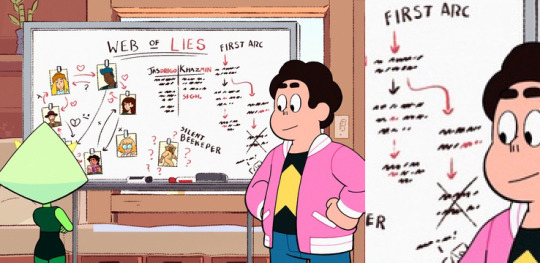
but like. Why?
Hypothesis: Steven Universe is made up of multiple timelines, but shown in an order that makes the events seem linear. read part 2 here!
I'm not the first person to speculate this at all. A lot of this stuff has been pointed out by @dogcopter @arrozbrillante @stevenutheories and many others on various platforms!
I just gathered the most conspicuous "evidence" into 1 post. If you’re interested in SU theory and analysis you should check out their blogs. :o) This was as short as I could make it..
And a big thank you to @love-takes-work for her podcast summaries!!!
So, most ostensibly there’s Garnet, who can see multiple futures. In Pool Hopping she begins to call her visions timelines specifically.
Garnet: In this timeline, we do the opposite of that. Hey, you! Have a pizza!

Steven: Hey, Vidalia's house is around here. Let's bring her the last pie.
Garnet: Now, that would be nice. She must be upset that her son was taken into space by those Homeworld Gems. (referring to the events of I Am My Mom)
Steven: You mean Onion? He isn't in space. He's right over there. *points*
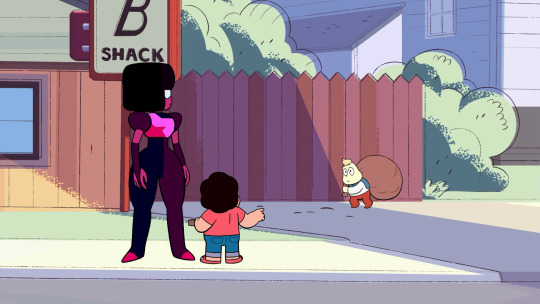
Garnet: Sorry, I-I must be thinking of a different timeline.
-
Garnet: My bad. I was sure we were in the pepperoni timeline.
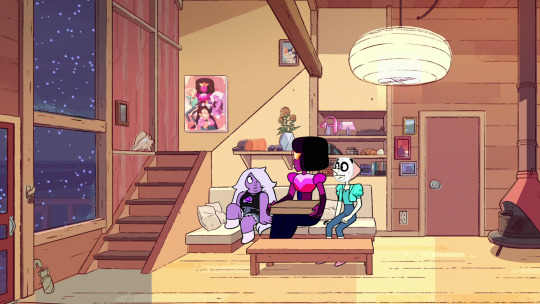
-
Garnet: It's important to keep in mind that all these horrible things did happen to you in alternate timelines. Safety is fun.
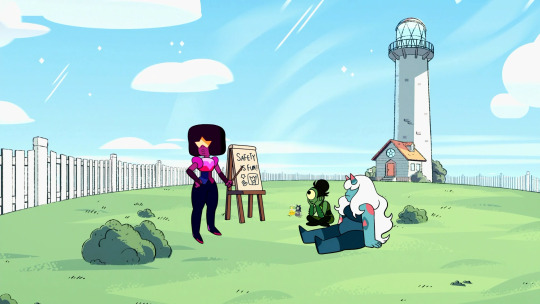
In Steven and The Stevens:
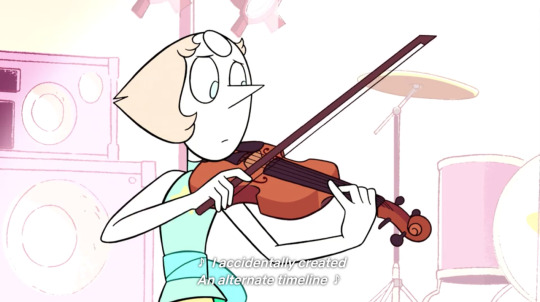
Yeah
It was confirmed on the podcast that the Steven we see from that episode on is a different Steven than the one from episodes 1-21. In “The Fantasy of Steven Universe” Sugar explains:
"I think, early on, we knew for sure what we wanted to do was to create episodes that feel self-contained but give you a new piece of information or change the characters fundamentally. So, Steven and the Stevens, is tight but Steven does change fundamentally after having that experience. He's not the same- in THAT case he's LITERALLY not the same character..."
It’s muffled because they're all laughing but right after they say this Matt Burnett goes “He died.”
Link to the episode
Love-takes-work also has a text summary of the episode
youtube
But something I haven't seen discussed very much is the time travel chase scene. Granted it’s very blink-and-you’ll miss it, there are some Stevens who witness the other Steven’s fighting but that don’t end up in the Sea Shrine at the end.
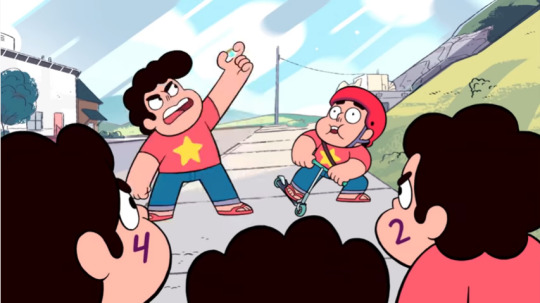
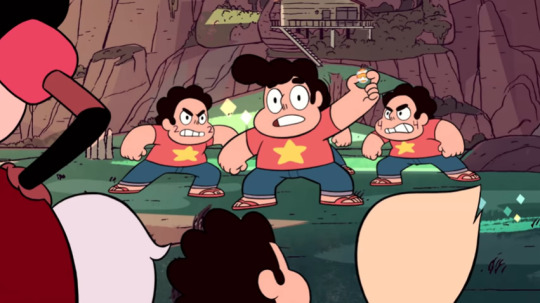
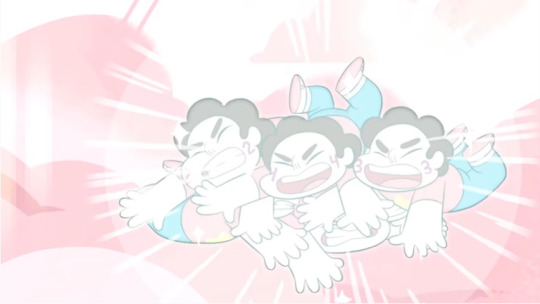
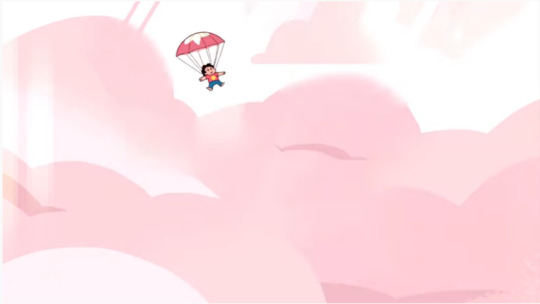
Way back in 2015 @stevenutheories already did the math as to how many alternate timelines may have stemmed from the time shenanigans: 3 to 5. Not counting the original one who is definitively gone.
Technically quantum mechanics don’t work like that and those Stevens should have been Thanos’d too. I’m not going to pretend I understand physics, that is just what I’ve been told by someone who does. But then again the magic time thingy wasn’t bound by rules of real-life physics in the first place… so ??
Let’s cross-examine SATS’ accompanying KBCW post.
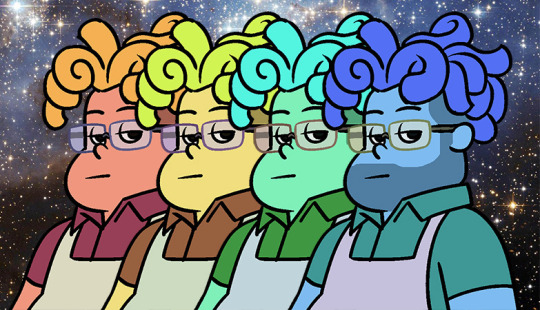
“At any given moment, if you asked me what I was thinking about, the answer would be one of two things: katana swords, or THE POSSIBILITY OF ALTERNATE TIMELINES RUNNING PARALLEL TO OUR OWN!
Proving the existence of these timelines can be pretty tricky, even for a seasoned paranormal investigator such as myself. An inter-temporal incursion caused by the momentary weakening of the time-space continuum doesn’t really photograph well. And all the cross dimensional time travelers I know don’t want to go on the record about their experiences. Frankly, the only thing I can submit as evidence of alternate timelines is the fact that THEY ARE PROBABLY JUST SO COOL AND AWESOME THAT THEY HAVE TO BE REAL.
Think about it! What about a universe where that asteroid missed Earth and we had DINOSAURS for pets instead of dogs? Or a universe where someone was like “Hey, zeppelins are way cooler than planes, let’s just do that!” Or a universe where AN ALTERNATE VERSION OF ME CAN GROW A FULL BEARD?! What an amazing life that Ronaldo must have… in THIS stupid reality I have a really hard time getting my moustache to connect to the rest of my facial hair and it’s incredibly frustrating.”
KBCW and Ronaldo’s commentary in general are usually half-right. Like the “Polymorphic Sentient Rocks are aliens who want to hollow out the earth… to make it lighter so they can transport it back to their star system” thing.
I can't help but think the "Dinosaurs for pets instead of dogs" is a reference to the live action Super Mario Bros. movie- where the meteor that killed the dinosaurs sent them to a parallel universe instead, causing mammals to go instinct in said universe. (Don’t know about the zeppelins.)
And then, and THEN there’s Keep Beach City Safe, KBCW’s more obscure rival blog run by (most likely) Onion under the pseudonym "The Observer". Apparently he’s planted cameras all over town to record Steven’s adventures. There's also a "Recruiter" and second mystery narrator calling themselves "Marco Díez", it's a whole thing,
Assuming it’s real, here’s one of the posts I think are the most relevant.
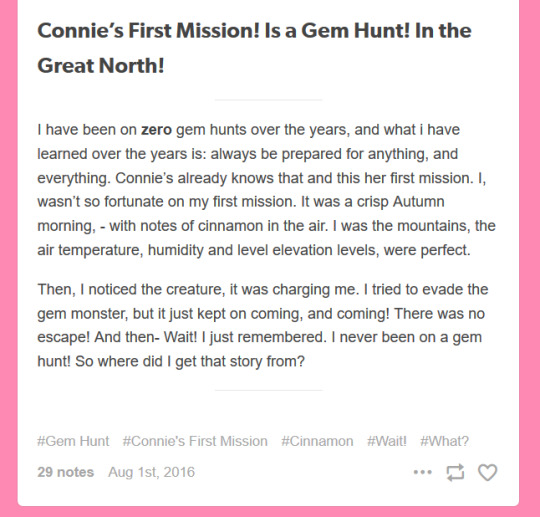
“I have been on zero gem hunts over the years, and what i have learned over the years is: always be prepared for anything, and everything. Connie’s already knows that and this her first mission. I, wasn’t so fortunate on my first mission. It was a crisp Autumn morning, - with notes of cinnamon in the air. I was the mountains, the air temperature, humidity and level elevation levels, were perfect.
Then, I noticed the creature, it was charging me. I tried to evade the gem monster, but it just kept on coming, and coming! There was no escape! And then- Wait! I just remembered. I never been on a gem hunt! So where did I get that story from?”
This was posted on August 1st alongside Gem Hunt… and the day after the Greg The Babysitter post, which was deleted earlier this year, right after people started interacting with it again.
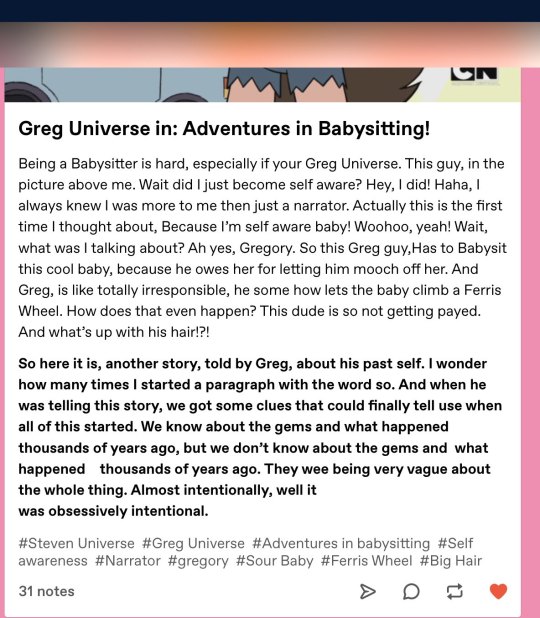
Being a Babysitter is hard, especially if your Greg Universe. This guy, in the picture above me. Wait did I just become self aware? Hey, I did! Haha, I always knew I was more to me than just a narrator. Actually this is the first time I thought about, Because I'm self aware baby! Woohoo, yeah! Wait, what was I talking about? Ah yes, Gregory. So this Greg guy,Has to Babysit this cool baby, because he owes her for letting him mooch off her. And Greg, is like totally irresponsible, he some how lets the baby climb a Ferris Wheel. How does that even happen? This dude is so not getting payed. And what's up with his hair!?!
So here it is, another story, told by Greg, about his past self. I wonder how many times I started a paragraph with the word so. And when he was telling this story, we got some clues that could finally tell use when all of this started. We know about the gems and what happened thousands of years ago, but we don't know about the hems and what happened thousands of years ago. They wee being very vague about the whole thing. Almost intentionally, well it was obsessively intentional.
?
There are subtle inconsistencies in Beach City's layout. ("The Observer" points this out, too.)
Remember Danny’s? In Bubble Buddies and Joking Victim, there’s a shop named Danny’s Salt Water Taffy.
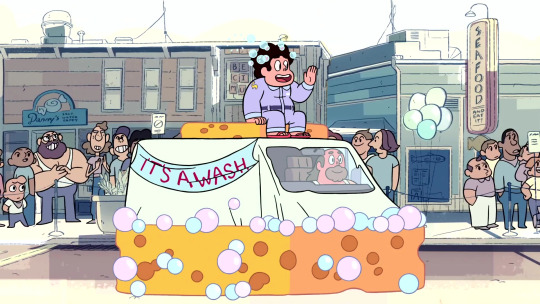
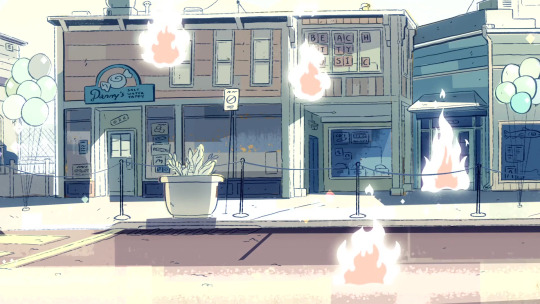
Then in Watermelon Steven it’s gone.
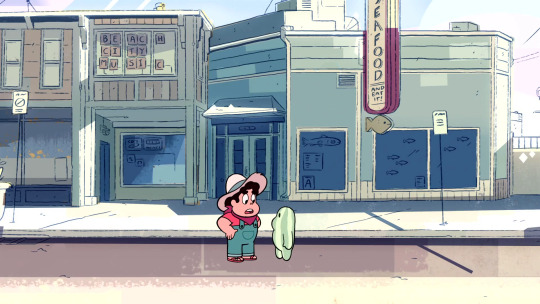
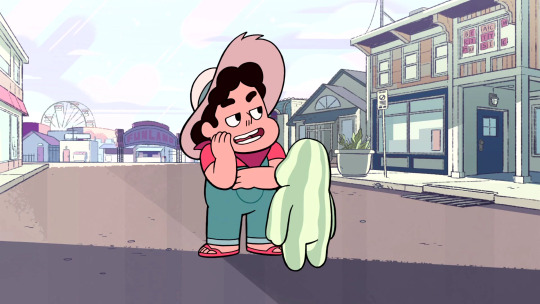
As for a prop: Chaaaaps used to just be Chips
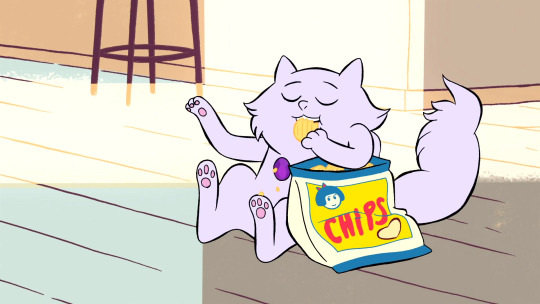
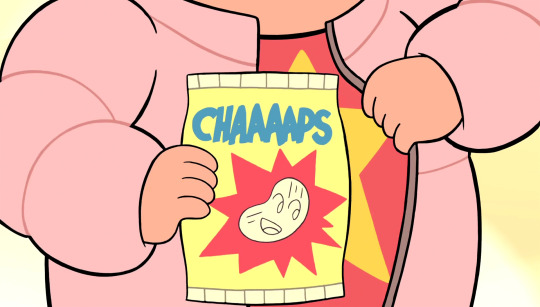
That’s from Monster Buddies, the episode right after Steven and The Stevens.
It's just as likely someone on the show simply thought the background/chips looked a little too busy or whatever. But re-doing stuff costs a lot of time and money, yknow? Neither of which is the animation industry very generous about. Did you know even props have model sheets?
Of course it could just be another brand of chips. Maybe Utz got involved somehow.
Lastly I want to highlight a quote from a Rebecca Sugar interview regarding SU ending.
“The story is continuing off screen and I do know what happens next, at least in certain timelines, for the characters,” Sugar says. “But I would have to decide how and when I’d want to dig into that, or if it’s best to give them their privacy.”
yeah so like what the fuck
#steven universe theory#su theory#long post#multiple timeline theory#deep lore#don't judge my blog theme im still working on it#only 2014 kids remember Danny's Salt Water Taffy
560 notes
·
View notes
Text
On Gondor and Nationalism
Gondor, and particularly Denethor and Boromir, is characterized more than any other realm in The Lord of the Rings by nationalism, and there is a sharp contrast between its actual role in the war and the way Denethor and Boromir percieve its role. Two quotes in The Return of the King form the core of Tolkien’s discussion of nationalism, and both are conversations between Denethor and Gandalf.
The first:
Denethor: Yet the Lord of Gondor is not to be made the tool of other men’s purposes, however worthy. And to him there is no purpose higher in the world as it now stands than the good of Gondor; and the rule of Gondor, my lord, is mine and no other man’s, unless the king should come again.
Gandalf: ...I will say this: the rule of no realm is mine, neither of Gondor nor any other, great or small. But all worthy things that are in peril as the world now stands, those are my care. And for my part, I should not wholly fail of my task, though Gondor should perish, if anything passes through this night that can still grow fair or bear fruit or flower again in days to come. For I also am a steward. Did you not know?
And the second, discussing Denethor’s views on what should have been done with the Ring:
Denethor: It should have been kept, hidden, hidden dark and deep. Not used, I say, unless at the uttermost end of need, but set beyond his grasp, save by a victory so final that what then befell would not trouble us, being dead.
Gandalf: You think, as is your wont, my lord, of Gondor only. Yet there are other men and other lives, and time still to be. And for me, I pity even his slaves.
Denethor: And where will other men look for help if Gondor falls?
Both of these conversations point to the fundamental flaw in Denethor’s worldview, and it is a nuanced one. He is not the weak, selfish old man presented in the films; he is intelligent, pragmatic, and realistic, and his strategy and tactics are thoughtful. Again unlike the movies, the mission he sends Faramir on - to prevent the armies of Mordor from crossing Anduin, and cause them heavy losses if they do cross - is not a pointless suicide mission but a crucial and tactically necessary battle. He is wrong in his attitude towards and treatment of Faramir, not in sending him into danger.
Denethor represents (as, in another way, does Saruman) the wisdom of the world. His statement that, as the steward of Gondor, his highest purpose must be the good of Gondor, would be approved by many political theorists. But in the wider vision of the story of The Lord of the Rings, expressed by Gandalf, it is critically flawed in its narrowness and arrogance. The war against Sauron is not about the victory or preservation of one realm alone; it is about saving anything and everything good in Middle-earth, in the present or the future. This is the moment when Gandalf comes closest, of any point in the story, to stating outright who he is and what his purpose is; he doesn’t say outright that he was sent by the Valar to preserve the world against Sauron, but he comes near enough to it that Denethor, an intelligent and learned man, could pick up on it if he wanted to. It is important to Gandalf to at least try to get Denethor to understand the importance of what he’s saying.
In the second conversation, though, Denethor has fallen still farther from the truth. In the first one, he only said that Gondor’s good had to be his highest priority, as its ruler; now he says that if Minas Tirith falls, Sauron’s conquered the world anyway and it doesn’t matter if he gets the Ring. In his eyes, Minas Tirith is the only thing standing against Sauron, and the only thing that matters; its defeat is to him synonymous with the destruction of the world. People across Middle-earth are fighting against Sauron: on the very day of the Battle of the Pelennor Fields, the elves of Lothlórien are fighting off an assault by Sauron’s forces, as are the wood-elves in Mirkwood; the Battle of Dale in which the kings of both Dale and the Lonely Mountain fall will be two days later. Gondor is not alone in this war; it is not the only realm fighting and not the only one whose battles matter. It is not the bulwark sheltering the peaceful rest of the world from war; the rest of the world is fighting. But Denethor chooses to regard it as the only place of importance.
These are perspectives that he passed on, in part, to his eldest son, as seen in some of Boromir’s deeds at the Council of Elrond as well as in his later temptation by the Ring. At the Council, he takes the tone that Gondor is unacknowledged and unappreciated and is doing all the work of fighting Sauron: “Few, I deem, know of our deeds, and therefore guess little of their peril, if we should fail at last...By our valour the wild folk of the East are still restrained, and the terror of Morgul kept at bay; and thus alone are peace and freedom maintained in the lands behind us, bulwark of the West...those who shelter behind us give us praise, if ever they hear our name: much praise but little help.” He also - very importantly - instantly conflates “Doom” in the prophecy he hears with “the Doom of Minas Tirith”: the same thing Denethor is doing when he says that, if Minas Tirith falls, the world has already fallen and there’s no point in keeping the Ring away from Sauron. When he is told that the Ring cannot be wielded to defeat Sauron by force of arms, he acts as though the other members of the Council are abandoning Gondor. And so the Ring tempts him with the power to save Minas Tirith, because that’s the only way he can concieve of for the world to be saved.
Aragorn’s response to Boromir, in speaking of the Rangers, is not a counter-boast but an attempt (like Gandalf’s with Denethor) to give Boromir a broader perspective: many people are fighting and resisting Sauron and other evil things, in their own ways (“the servants of the Enemy...are found in many places, not in Mordor only”). Gondor is not alone; it is playing one particular role, while others play other roles.
This attitude, that its battles are the only ones that matter, is quite unique to Gondor. Legolas and Gimli, fighting in the wars of Rohan and Gondor, recognize that their kin cannot come to them: “They have no need to march to war...war already marches on their own lands”. The hobbits continually think little of themselves and their actions, even while achieving great things. (One example that amuses me is the contrast at the Council of Elrond between Boromir, who thinks his comparatively uneventful journey quite heroic - “since the way was full of doubt and danger, I took the journey upon myself” - and Frodo, who regards his achievement of escaping to Rivendell while pursued by all nine of the Nazgûl, and surviving a wound that would have been worse-than-fatal to most other mortals, with an attitude of ‘well, I rather muffed that up’.) The Ents very much have their own priorites - Treebeard says “I am not really on anyone’s side, as no one is really on my side - no one cares for the woods these days” - but they involve themselves in the war beyond merely defending Fangorn, by destroying the orcs who invade Rohan from the north. Théoden likewise keeps the big picture, not just the narrow ‘good of Rohan’ in mind, continuing with his army to the relief of Gondor even as news comes of Rohan being invaded from the north and east (the aforementioned orcs whom the Ents deal with).
Frodo comes closest to understanding what Gandalf is saying in the first-quoted conversation with Denethor. After seeing the Witch-king’s army march out from Minas Morgul, Frodo is tempted to despair: “Even if my errand is performed, no one will ever know. There will be no one I can tell. It will be in vain.” But he resists this: what he had to do, he had to do, if he could, and whether Faramir or Aragorn or Elrond or Gandalf or Galadriel or anyone else ever knew about it was beside the purpose. Aragorn, too, understands it: the march on the Black Gate is the antithesis of Denethor’s perspective: sacrifice of the armies of Gondor and Rohan without even knowing what may happen after they are defeated, in the hope that they may enable someone else to win the victory. They have no way of guessing that Frodo and Sam will reach Mount Doom at the same time as the armies clash at the Black Gate; their hope is founded on the idea of distracting Sauron long enough that Frodo and Sam can destroy the Ring days later, after the armies are all dead.
And Denethor and Boromir’s attitudes are all the more ironic because, in the end, Gondor doesn’t hold up very well. They fall apart and stop even trying to man the walls of Minas Tirith after a mere two days of siege, when food supplies haven’t even begun to be an issue. For a fortified city, especially one as well-designed for defense as Minas Tirith, that’s a very short amount of time to hold out against a siege! During the march on the Black Gate, even the sight of the Plains of Gorgoroth is too much for some of the men of Gondor and Rohan, and they can’t keep going. Yes, they’re just regular people and have never seen anything this horrible before, but Frodo and Sam and now Pippin are also just regular people used to peaceful lives, and they keep going. The purpose of this comparison isn’t to run down the Men of Gondor, but to point out how deeply wrong the idea is of them being the only ones whose fight matters, the only ones with the nerve and determination to protect the rest of the world. The hobbits, who don’t think of themselves as anything special or important or strong, are the ones who save the world, and they do it through hope, endurance, self-sacrifice, love, and compassion, not through military might.
322 notes
·
View notes
Note
I used to want to be an artist but then i stopped drawing for like 7 years. I want to go back but i'm scared and dont know where to start. So yes, i am interested in those drawing videos can you post them if you dont mind? ^_^
Of course!! I am in the same situation as you actually. I used to draw a lot in middle school (2010-2012) but my depression worsened during high school and in college, I’d only draw as a distraction, never seeking to study or improve. I decided to get back this year, since I decided drawing was the only thing I could see myself doing professionally. I felt very lost, because how do you get back? How do you know what’s your actual, current, art skill? What are your weaknesses? Your strong points?
That’s how I learned to study the fundmentals of art. Because visual art is not a skill. It is a set of skills, if you are very good at anatomy but not really when coming to painting your art is going to look differently than someone who learned anatomy in how to draw manga books but paint like a pro. I am going to divide this post in categories, Also, all the videos I link I also recommend all the channels they are from! My favorites are The Drawing Database, Sycra and Ganev, Sycra and The Drawing Databse have a little of everything and are great at explaining. Ganev is a bit sarcastic but I like the way he teaches. I took some parts of the text of this post from here.
How do I begin? How do you even get back at art? What tips should you use? These are general tips videos, usually nice to draw along. /the fundmentals and how to get started/ /5 tips for better drawing/ /perfect pratice/ /beginner’s guide/ /5 tips for digital art/ /10 tips to improve/ /why your drawings are stiff/ /what level is your art/ /improve your art fast/ /drawing basics/ /how to hold and control your pencil/ /intuitive drawing method/ /iterative drawing/
The Fundamentals: Proportion & Placement Proportion is relationship between one element and another. In the visual arts proportion relates most importantly to the abstract quality of scale and placement. You know how stereotypically an artists puts a pencil to their eye when looking at an object? They’re mesuring the proportion of the object in question and how to represent it corectly in the drawing. /principles of proportion/ /ways to create illusion of space/ /drawing the human figure/ /how to draw proportions playlist/ /how to use proportion in character design/ /basic anatomy and proportions part one/ /part two/ /part three/ /part four/ /proportion basics/
Form & Construction The idea of form is how we see the 3D objects in or world and transform them into 2D in the paper/canvas. It’s understading that eveyrthing is made up of basic forms. /dynamic sketching part one/ /part two/ /how to draw forms/ /structure/ /building form/ /another how to draw forms/ /how to visualize 3D forms/ /form study process/
Perspective & Depth Perspective is knowing that as things move away from the viewer’s eye, things seem to get smaller. Get familiarized with terms like horizon line and vanishing point. This is the basic that must be understood to learn perspective. Here’s a good article about this. /an intro video on the subject/ /step by step tutorial/ /perspective basics part one/ /part two/ /part three/ /part four/ part five /part six/ /another basics video/ /20 perspective lessons/ /eye level tip/ /linear perspective/ /simple form perspective/ /drawing the figure in perspective/
Anatomy Anatomy is something I think it’s one the most crucials things to learn in order to make your drawing look good. Once you understand how joints work you’ll be able to see how bones and muscles move. And this goes for anything with a skeleton. It’s one of those things of you learn the rules before breaking them. I am linking different playlists, since linking different videos on various parts of anatomy would take forever. Just study a body part at time: head, eyes, nose, lips, ears, shoulders, neck, hairline, breats, torso, hands, feet etc. /how to do an anatomy tracing/ /playlist 1 / /draw the head from any angle/ /anatomy for artists/ /draw facial features/ /how to draw and paint/ /playlist 2/ /draw 3/4 head with loomis method/ /playlist 3/ /drawing a head in 3 hours (this one is great to draw along with the artist)/ /how to draw a body/ draw a head with loomis method part 1/ /part 2/ /part 3/ /decipgering bridgman’s anatomy/ /anatomy quick tips/
Gesture Gesture drawing is a method of capturing figures in exaggerated poses, usually drawn quickly. It is important to undersand that the goal of all gesture is to study the figure and see how it moves. I like looking at poses and copying them. Here’s a good article. /how to draw gesture/ /how to draw any pose/ /draw interesting poses/ /a guide on gesture drawing/ /tips for expressive dynamic poses/ /figure drawing tips/
Composition The overall layout of a piece is very important. Artists often consider things like the rule of thirds or the infamous golden ratio. Neither truly defines a composition, but they can both go into your decision making. /composition in art/ /understanding composition/ /10 composition tips/ /beginner’s guide to composition/ /art fundamental: composition/
Value Studying value is very much the study of light and shadow. But there is a technical side of light that you’ll want to pay attention to if you’re going for technical rendering. /guide on rendering/ /seeing light and shadows in daily life/ /10 minutes to a better painting/ /understaing colors and values/ /shading basics/ /ambient occlusion/ /shadow colors/ /tips on how to shade/ /draw shadows on objects and people/ /lighting tutorial/
Color Theory Color theory is understanding which colors go good with eachother, and knowing the pyschology behind it. (what are cool colors? what colors make someone feel comfortable?) It is fundamental in art for you to understand the relationship between colors and what makes them look good. Best color theory books. A comprehensive guide to color theory. /hue value saturation in photoshop/ /color theory for noobs/ /understanding color/ /what you should know about colors/ /warm and cool colors/ /the basic elements/ /choose colors that work/
Traditional Media If you draw in traditional media, all videos above can be used easily. These are just videos for general tips in traditional media, there isn’t many since my focus is digtal ^^’ /watercolor tips/ /draw with colored pencils/ /blending colored pencils/ /4 how to draw lessons/ /Block in colors/ /holding the brush/ /
Digital Media Digital art is how everyone’s been doing art these days. It doesn’t matter if you’re doing with your phone or your computer. I don’t do art on my phone, I know the most used app is mediabang for android and procreate for apple, and I think anyone who is able to do art with their finger is very skilled. If you are like me and prefer doing art on your computer, you probably have your tablet. If not, well you should have. Not having a tablet is not an option if you want to get better at art ^^’ Best tablet for beginners in 2020. Or you can just buy an old used one, if it still works, and you are a beginner, a small intuos is all you need. When talking about softwares, the three big ones I see people using are: Photoshop, Clip Paint Studio and Paint Tool Sai. The best one is CPS, but I find Sai easier to navigate, but CPS is extremely complete and I hope to be able to master it someday. CPS Tutorials. I don’t have much to say about photoshop, people use it mostly because they’ve been using it forever lol I divide my digital painting process in steps: Sketch/Lineart/Color Blocking/Shading/Blending/Color correction. Sketch is the basics, draw your idea. Lineart is to clean your sketch. Color Blocking is to color your drawing one color, so it’s easier to work in it. Shading is to understand where the lighting sources are coming from and apply them. Blending is to blend the colors of your drawing with brushes. Color correction is when I use filters of hue/saturation and others to make the drawing more appealing. These require understadings of the software of your choice which I am not very good at the moment so I can’t give you more tips than that ^^’ Hopefully these videos can help. /perspective grid/ /clean line art/ /coloring process/ /make lineart interesting/ /best brushes for digital painting/ /skin shading tutorial/ /lineart vs painting/ /art in clip studio paint/ /hair tutorial/ /3 tips for improving/ /10 digital art mistakes/ /color block tutorial/ /shading skin/ /from lineart to painting/ /cleaner lineart/ /add texture to your art/ /improve your art with better shadows/ /the importance of brushes/ /use layer modes/ /improve your lines/ /how to blend colors/ /another blending tutorial/ /color blocking/
Exercises It’s no secret that to improve on art, you must pratice. Everyday, even if it’s just a little! A great way to pratice is make use of youtube picture in picture function to draw along in your software of choice. /pratice drawing forms/ /proportion exercises/ /perspective exercises/ /value studies/ /creative drawing exercises/ /simple drawing esercises/
Resources Senshi stocks, a deviantart page full of poses photos. Quick poses, pictures of models, contains nudes. Character design references DesignDoll, create a personalized sketch doll and make it pose.
Phew!!! This took forever to make and is way more than you asked for, but I decided to go all in so I can have a masterpost for me too and for anyone else interested in art. As soon you can understand the fundamentals, you can do your own research and study, youtube is really great for this. I hope this helps, let’s get better at drawing together!!! Ganbarimashou (ง •̀_•́)ง
#anon#askbox#I feel there's a lot more to add but I'm tired I've been working on this sicne yesterday ^^'#Like there's more softwares and resources I could link you I know of that#So when I think of something else I may add to this psot#post#if you feel overwhelmed because this is a lot of info you can start with the beginner section of this psot#and sycra's channel
85 notes
·
View notes
Text
It is hku’s 6th month anniversary, and it’s been a growing theme (tradition?) that I tend to write essays for said occasion, most of them being jokes. But instead, today I present a different kind of essay, one that isn’t written as a joke for once. This is an essay focusing on the grey morality of hku, and focuses on Siv as the example of said grey morality. Because of this, I do have to warn that there are major story spoilers ahead, so if you haven’t read hku or aren’t caught up to current events, I would recommend not reading this! This essay isn’t going anywhere, and spoiling yourself isn’t a very fun experience!
With that disclaimer out of the way, the essay (as per usual) is under the cut! Enjoy!
~~~
The Grey Morality of HKU
We live in a world that is not purely black and white, but instead many different shades of grey. Writing greyness into stories is difficult, especially when trying to create morally ambiguous characters, which is why most character conflicts in fiction is black and white. Moral greyness in characters is a very thin tightrope to balance on, since such characters fall in between heroes and villains, and bring layers of depth and complexity into the world. Most humans are not purely good or evil, and morally grey characters showcase this well. These characters can be incredibly complicated, and thus, it's difficult for authors to commit and stay on their tightrope. Sometimes they lean too far to one side and their intended moral greyness gets destroyed. But in Hyrule Kingdom Updates, or HKU, Quill not only walks this tightrope with ease, but does backflips on it and performs a whole circus act with their characters mimicking the same routine. One of these talented tightrope-walkers that performs in such a circus act is Asivus Hartell, better known as Siv.
Siv is one of the main examples of the grey morality of HKU. He’s the sarcastic, pessimistic orator that serves as the role of the narrator for the story. Introduced as a psychological egoist, or someone who believes that everyone’s actions are derived out of personal interest, his personality, attitude, and actions all reek of the scent of “villain”. He’s cynical, hates almost everyone in the castle, and is also a criminal. Over time, his egoist beliefs are slowly challenged, and when his ties to the people who challenge his egoist morals are cut, his egoism goes even further downhill, leading him to become a utilitarian existentialist.
Utilitarian existentialism is hard to properly define, as there is no clear-cut definition. It is the combination of two different philosophies, utilitarianism and existentialism. Utilitarianism is the belief that actions are right if they are useful or for the benefit of a majority; if it provides the greatest amount of good for the greatest number of people, it’s the right thing to do. Existentialism is the belief that there are no set morals for life and no specific meaning to life— people are free to create their own meaning and define their own existence. Utilitarian existentialism is the combination of these two beliefs, and Siv falling into this moral belief can lead to its own opportunities, both for the plot and for himself.
Siv, by the dictionary definition, is a villain. One of the core beliefs he holds, mostly thanks to his egoism, is that everyone is a terrible, selfish person except for him and Ganon. This is not only harmful to the rest of the population because of the possibility of the Calamity being revived, but it’s harmful to Siv as well. Thinking everyone is bad except for the entity that’s weaponizing your malice, or manipulating your trauma, is not the most healthy thing. In addition, as the readers, we can see things from multiple perspectives, and therefore know that not everyone is a terrible or selfish person. By seeing these multiple perspectives and knowing these things, we root against Siv and his goal of resurrecting the Calamity, for his view of the world and the people in it is flawed. Siv succeeding in his objective wouldn’t be good for anyone, including himself. If this was Siv’s only belief, it would be more of a clear-cut black and white story, and Siv would just be a villain. However, that is not the case.
The other core belief Siv believes is one that Astor leads him to: Getting rid of all the terrible, selfish people in the world is the morally correct thing to do, as the kingdom would be a better place and he’d finally be happy. “Defeating the evil in the kingdom will make everything end up good” is a mindset that many stereotypical heroes share. This is the belief in the stories of many people’s childhoods, and people root for them because it’s usually correct in the context of said story. There’s nothing fundamentally wrong with Siv’s belief; he does have a point and does deserve to be happy. Furthermore, most of the problem causers in Hyrule would be gone, preventing all the hurt and trauma all the characters have to cope with from happening again. For example, getting rid of Ligero is something the entire reader-base has been cheering for since the old man was first introduced. It would be satisfying to see people such as those face consequences for their actions, and as readers, we like satisfying endings. Unfortunately, the problem is that Siv believes everyone is bad except him and Ganon, so he’d be getting rid of everyone, and effectively resurrecting the Calamity, something that devastated the kingdom and brought a massive amount of death, in the process. Taking that into account, you wouldn’t want Siv to succeed. And as a bonus, killing anyone and everyone he could possibly care about in any capacity would not be good for his already crumbling mental state. All of this creates a mental tug-of-war in the reader’s head, because they're rooting for Siv to succeed but also hoping that Siv will fail. Is he in the right? No, because not everyone is a bad person and killing everyone by raising the Calamity isn't ever the right thing to do. But is he in the wrong? Also no, because utilitarianism isn't inherently bad, neither is existentialism, and the moral principle itself can have good intentions. Quill writes Siv to be a very complex character with no absolute right or wrong mentality. There’s no surface answer to if Siv is correct in his thinking or not, as this moral greyness goes a lot deeper than the surface level you see within the dialogue.
Siv walks upon the same morally grey tightrope that we, the readers, fight ourselves over within our own mental game of tug-of-war. His moral ambiguity is a huge part of his characterization, as well as a major highlight on the plot of HKU as a whole. The picture Quill painted is not only in multiple shades of grey, but also full of color and life. And out of all the shades of grey Quill used in their masterpiece, one of the most interesting shades is Siv. Quill did an excellent job at exploring this moral greyness and it shows well; you can truly see the care that they put into Siv as a character through how he affects the world around him. The kingdom of Hyrule is not made of black and white, but instead, is painted in multiple shades of grey that reflect our own world within itself, since nothing is as simple as it seems.
~~~
Want to read more about Siv’s morals? Quill wrote an in-depth explanation themselves, and does a much better job of explaining it than I do, so I recommend reading it if that peaks your interest! Click HERE to be sent to that post! (also major spoilers, so be warned)
~~~
Now, since you got to the bottom of this post, and because I might be a little too polite, I need to give some thank-yous to a handful of people.
The first thank-you is to Rev (@swordlesbianss) for giving me the push I needed to actually write this thing! You pretty much kept me accountable for getting this done by mentioning your essay (which I look forward to reading when it’s ready, take your time), so thank you, Rev! You definitely got me to actually start writing the original version of this essay, and caused me to write it to where it is now!
The second thank-you is to Aura (@auroraborealis1890) who beta read the first draft of this essay! You made sure it wasn’t completely incomprehensible, thank you so much Aura! By being able to read it at all, you were a huge help to what was essentially a crazy person’s ramblings. You’re a great friend and I’m very grateful you read my first draft of bullshit <3
The third thank-you is a huge one to Bunny (@bunnywabbit229) who polished up this essay! All of the tone, spell checks, and really beautiful analogies were proofread by Bunny, some invented by them! They took a good 5+ hours out of their day and made this little rock of an essay become the shining diamond it is! I could point out so many things that they made better, but I don’t want to gush for too long. Bunny, I know I already told you this but if I could buy you a large brownie pizza, I would because you helped so much and I appreciate it so much!
The final thank-you is to Quill, the author of @hyrule-kingdom-updates, who made the inspiration for this essay. You have made such a wonderful story that’s rich with so many amazing characters and astounding worldbuilding. You made a masterpiece that inspired an essay of over 1000 words and I’m in awe. You truly deserve to know how wonderful your writing is and all the effort you’ve put into your characters and story is not going unnoticed. So thank you so much for putting your story out into the world, Quill.
#hku#hku spoilers#<- got that out of the way now time for the writer's cut in the tags#this was originally going to be an essay about Siv and Larc and how their morality challenges our view of it#Siv is moral. Larc is immoral. You'd expect them to be opposites. But they're not#as time went on Siv slowly started taking over the essay entirely because there's just SO MUCH TO HIM#so the topic shifted into an essay about the moral greyness of hku and used siv as a prime example#it eventually got to this point (which is fortunate because that other essay was going to be even worse that this one)#also the tightrope analogy with a bit of circus theme is half inspired by some google stuff about how hard moral greyness is#and half inspired by the fact that i am a clown honking my little clown nose at 3am trying my best#also another tangent: if you were awake around 1am (est) and you heard me going insane on a google doc#the first draft of this essay was that google doc but i didn't want to say it because what nerd writes essays at 1am#(i am. i am that nerd)#anyways#thank you for reading all of this!#i hope you have a wonderful day/night/whatever time!#<3
16 notes
·
View notes
Text
Hell is just a beat away (3/9)
Despite early promise, young Maul has turned out to be a disappointment, willfully delaying his training with secret attempts to make himself friends from scrap metal. He must be properly motivated, and so Darth Sidious sends him to a slave market on an impossible mission. It backfires. Star Wars: Darth Maul (2017) comic AU | 5.2k | warning for slavery, sexual assault of a teenager (non-graphic)
Ten to doomsday, moving fast
Eldra does not sleep. She refuses. If she has to bite her fingers bloody when her eyelids threaten to drop, then so be it. Master Fyaar would have chastened her for it—she always insists that Eldra be at her best regardless of circumstance, and staying awake for what must be more than one or two entire standard days now will help with neither her innate distractibility nor her willful emotions. Her secret inadequacy, unknown to all but Fyaar, who chose Eldra when she was ten and had yet to develop the mind that is, and she has rarely admitted to those fears even in the privacy of her own brain, the mind that is perhaps fundamentally unsuited to the noble path of the Jedi. Sure, she does well enough in her classes, though she drives her teachers to frustration with her incessant fiddling with any trinket at all within her reach and her doodling and her daydreams. Sure, she mostly behaves acceptably among people, though she does not pick up on the right cues to be a diplomat and she vacillates too often between excited talking and secret loneliness, when she, once again, finds her peers more interested in each other than in whatever she has wanted to share. Her one friend in the Order is Bayro who’s two years older, though now she’s not even sure if Bayro would see her as more than a friendly, clingy acquaintance, and—
Will Bayro even miss her? They’ve made plans to watch a holovid after Eldra’s back from Teth and Bayro aces the Advanced Test on Coruscant Sublevels 6665 through 7900. Vague plans, though, and since Eldra didn’t know how long she’d have to guard Mayor Woobudg… Bayro will probably notice in a few months that Eldra hasn’t returned to the Temple, and then watch the holovid with one of her many other friends. She’ll—
Watch your feelings, Eldra, she remembers. It hurts. The memory of Master Fyaar hurts worse than even the imaginary indifference of Bayro does, but it’s necessary. As ever, Master Fyaar’s warning is right, even if it’s only the ghost of Fyaar living on inside Eldra’s grief. Eldra almost lost her calm over a scenario of her own imagination, yet another reminder of her unsuitable mercurial temperament. Yet another reminder of why she needs Fyaar, needs her constant watch, if she wants to remain on the path of the Jedi.
And Master Zalandas Fyaar is dead.
Fyaar’s dead.
Eldra watched her murder, and the murder of everyone she was supposed to protect on this mission. Eldra watched her murder and did not reach for the dark side of the force to avenge her. Eldra watched and held still.
Eldra allowed herself to be abducted.
She does not sleep in her tiny cell, just as she didn’t sleep on the freight ship that carried her to an unknown planet far away from bloodied Teth. She didn’t sleep then as stubbornly as she does now, but even before her wide-open burning eyes the pictures will not stop. The blood. The touch. The grin of her vile captor when he said that she would fetch a tidy sum, despite being a blue twi’lek (“A dime a dozen, they are, and this one’s not even a trained dancer! She hasn’t even… look!” Her captor had pulled her upper lip away then, and she had snapped for his fingers. “She’s still got those awful sharp teeth! Who the hell lets a twi’lek girl walk around with sharp teeth? She could tear a guy’s throat out, with these!”) she would still be worth a quick sale to her captors but only because she is (was) a Jedi padawan, and apparently there are quite a few pieces of shit out there who’d like to hurt a Jedi. Or—she keeps her eyes open, open, open till tears threaten to drop, and yet the thought comes. Or fuck one. Same difference.
A toy that’s padawan-shaped. That’s why they let her keep her own robes. But at least they did.
Watch your feelings, but still, Eldra shakes to her very core. She’s never thought of herself as being anything but a person, slightly inadequate perhaps in all ways that matter to her but a person; a luminous being, a small conduit for the very force to act through in the material galaxy; but now she’s been caught and taught that what she is is actually just a twi’lek girl. Cheap. Interchangeable. Nothing but her species and her gender, nothing but her flesh: a pretty dancer, never mind she hates dancing and if she ever makes it out, if the Jedi find and rescue her, please, please, she will never ever dance not even a single one of those silly novelty dances ever again even if Bayro does it first. She’ll go to whatever lengths needed to never be appraised, judged, looked upon, perceived as anything but a luminous dutiful Jedi ever again.
To these people, she’s not a person. Not a Jedi, unless the fetish counts, not really, not to the slavers and—watch your feelings, but still, the seething disgust returns and she wants nothing more than her lightsaber through her captor’s hearts or their hands torn off by her teeth—perhaps, maybe, please no, not truly anymore either to herself.
⁂
Maul wakes up to insistent beeping. He’s never heard the noise before, except—somewhere behind the headache and the nausea he remembers—except roughly five minutes ago, and five minutes before that, and five minutes before… He’s read about those periodical noises. Snooze button on an alarm clock, they’re called. He’s never used them before. He’s never used—Master teaches that a slothful tool is a tool broken, useless, and he’s never before dared to oversleep, even with his throat swollen and filled with mucus he didn’t, but now—it is a mercy he does not deserve, that Master was not here to witness Maul fail so deeply on this mission and just because something beats a booming drum inside his head and stuffed his stomach full of eels twisting up languidly through his esophagus.
Not real eels, though. He checks his vomit after throwing up. No eels. No animals hatched inside him; it’s just an inconvenient illness. And he feels better already, after spewing out the clear oily water and half-digested bread and no eels whatsoever. He does feel much better. Definitely. Illness during his mission would be inconvenient.
He has ample time to travel to the palace of Xev Xrexus before the padawan is sold there. Time he is grateful for, because Master’s ship will not let him in, so he has no access to his stilts or anything else he prepared apart from his cloak and the vocoder mask he carried in his satchel to the convenience store like a talisman of ingenuity and pretense. He doesn’t have his finest Sith robes that he left safe inside, only to be worn in the moment of Darth Maul’s triumph, and most of his weapons, too, apart from one anonymous knife strapped to his shin, are still tidied away in the ship Master gave him that will now pulverize anyone who dares approach.
Luckily, Maul is both incredibly clever—he figured out the location of the padawan! Despite Master giving him a wrong date and location! Solely by his own superior Sith cunning!—and he is within another sucker’s ship now—he sliced the lock in minutes! Because he is Darth Maul!—and the ship is full of new tools for improvisation.
Such as the large pair of black sunglasses that helps guard him at least slightly against the sun’s sickening poking and poking and poking of his cerebral cortex. Such as the trio of black shirts that, belted with a strange deltoid strip of fabric, bulk up his frame considerably and also make him feel toasty warm. Nar Shaddaa is cold, but Maul isn’t. Yet another victory to add to his tally.
With the gloves and the vocoder mask and the Sith cloak added on top, every square centimeter of Maul’s flesh is covered, and as he struts in front of the berth mirror he decides: he looks both incredibly dignified and scary, not to himself obviously but to those forcenull denizens of the underworld who will yet learn to tremble before the almighty Sith. He looks almost as impressive as Master. He doesn’t have the pale chin lurking under his cowl, obviously the most Sithly of looks, but in a pinch the black leather covering his cheeks and the opaque gridded speaker over his mouth should do almost as well.
Before he leaves, he ransacks the ship. No point in abandoning tools he might yet use. Everything he can carry, he stuffs inside his satchel.
Then, he begins the long pedestrian march to the palace of Xrexus. As usual, while he walks, he seethes in the Sithly anger of how much faster he could go if only he had a decent speeder bike. Soon, he reminds himself. Soon. After the oncoming awesome success of this mission, Master will be impressed enough to bestow the title of Darth and gift him a CK-6 swoop bike tuned up to the limits of terrestrial speed. Soon. Besides, with how slow the nausea is to settle, it’s perhaps a tiny bit useful that he is forced to take this brisk long walk in the Nar Shaddaa morning air. Although his coat and shirts fluttering with the speed of his bike would look very cool… He loses himself in his daydreams, and before long, he spies a duo of falleen in white dress shirts and black pants before the palace that belongs to Xev Xrexor.
The most adventurous part of his mission has just begun.
“Greetings,” Maul growls haughtily with the handsome baritone of his vocoder. “I have chosen to purchase a Jedi slave today. I trust this is the location for these sorts of errands?”
“Are you on the guest list?” the left falleen asks.
Guest list? Yet another complication. But Maul must not fail. “I am Ma Goweelr,” he says, borrowing the name of the man whose ship he ransacked. He found an identification card with his name on it and wisely brought it with him. He pulls it out now.
“You don’t look like Goweelr, friend,” she says.
“Unfortunately, I had… an accident.” Blast. They cannot see his face, so tt’s the height issue again. If Maul had his stilts, he could have made his way through easily, but because Master saw fit to lock the ship—no, it’s not Master’s fault. Because Maul was stupid enough to leave his tools aboard the ship, he now falters. What to do. What to do. What to—
“He’s slow,” the other bouncer whispers to his partner, but loudly enough that Maul heard it without issue. He stares intently at Maul, almost if he was expecting a specific reaction.
The left falleen winks. “All right. A little grease in the palm goes a long way, friend.”
Grease? Necessary for the function of machines. Cooking, apparently, also. Often a type of fat, either animal or plant-based, though hydrocarbons mined on certain planets or synthesized in labs such as Corellia’s X-Tech Max nowadays are a far more affordable and controllable—
“He’s dumb, Brighta. We don’t care whether you’re on the guest list. We want a bribe.”
A… Maul’s certain he read about bribes somewhere, but—
“Cash. Money. Credits.”
Credits! Maul found some on the ship. Since they were light enough, he put them in his satchel. The force is with him! He pulls out the chits he found, rummaging in a perhaps less than dignified way—the falleen exchange a look over his head that he’s too busy to try to read, but it doesn’t seem hostile—and when he hands over five thousand credits their vague non-hostility turns to genuine excitement.
“House Xrexus is honored to host you for this auction, sir,” the male falleen says when he opens the door.
“As am I,” Maul replies with a bow. When he walks past, the female bouncer taps him on the shoulder and then bends down to whisper in his ear.
“The Jedi’s auction’s in two hours, but the preview starts in one and she’ll probably get snapped up then, so. Might wanna hurry.”
“Thank… you?” Maul rumbles and winces at the vocoder turning his slight surprise into a question, but the falleen does not laugh this time.
“Appreciative customers are rare. Come back anytime,” and she winks and pushes him with her—warm, strong, startling—hand the rest of the way through the door and then slams it shut.
Presale. Other customers. Complicating factors Maul would not even have known about if it wasn’t for the bouncer—and for the force, therefore, willing him to succeed—because he didn’t… He did not actually expect any competition. After all, there are no other Sith but the Master and his apprentice. Who, then, would have need of a Jedi padawan? Who has need of Xrexus’ auction at all when they are not sent by their Master? Their… Master. Master might compete with Maul at this sale, both as a test of Maul’s readiness and as a failsafe, should Maul not manage to succeed in his mission. Master is incredibly smart after all, and foresees any number of possible twists and turns of a scenario, as unlikely as they might be. Even such unlikely eventualities as Darth Maul not completing in his mission. Master considers everything. It’s why he’s the Master.
Luckily, Maul was forewarned, and so when he passes a fire exit plan of the palace that’s nailed to a wall in the empty entrance hall he looks for any possible… There. A server room. A small bureau. Two places where Maul might gain access to the databases of Xrexus and convince the filing system that he has already bought the Jedi, before the first competitor has even placed their bid. It’s the only surefire way of preempting a person as thorough and prompt as Master is, and besides… Maul understands machines. He can charm and bend them to his will. His confusion at the bouncers’ hints and the tip the falleen gave him when he would never have expected anything of the sort based on the way the previous part of the encounter had passed—never mind the blasted lack of his carefully constructed stilts—were a sore reminder that in the field of people Maul does not yet excel to the standard of a Sith. Something he must remedy, but perhaps not on a mission as important as this. (Perhaps not among people who are oily and stare too hard.)
Laughter peals in a room straight ahead, but the server room is one floor down a side staircase. It’s sectioned off by a dangly gold chain that Maul needs to barely duck to pass under, and no-one passes through either the main corridor he left or the dusty unlit staircase while Maul hops down, thinking I am Sith alternating with I am shadow on every step.
The hallway leading to the server room is just as deserted. The door is locked, but Maul has sliced the access pads of twelve ships now and has refined his technique to under three minutes of elegant fiddling. This lock takes two seconds.
A datapad is already hanging inside right next to the door, from the cable with which it’s plugged into a socket there. Maul picks it up. Its screen is thrice-cracked and fixed up with clear tape. The touchscreen is incredibly sluggish to react, but as much as he might love the challenge of repairing it he only has less than an hour to spare. If he must, he will, but—gloves. He removes the right one, and the datapad responds.
A login screen.
Thus-far, the security has been abysmal. Worse than what he improvised for the secret hiding space of the first functional droid he built, and so he enters root, root. It works.
Pathetic, Maul thinks. Disappointing. Embarrassing. Horrendous. Useless. Awful. You deserve this. You deserve worse. It almost takes off some of the giddiness at how well Maul has been performing on his mission, thus far. His opponents are veritable morons. It is no great feat, to succeed against people as unprepared for basic survival as these, and it does not take a Sith’s cunning—it’s not worthy of the great Darth Maul who learns under Darth Sidious the greatest creature in the galaxy—to fight them.
In the central database he changes the status of the Jedi padawan to Sold and the buyer to Ma Goweelrand types in 666666666 for the winning bid. It’s a large number, and Jedi means valuable. It should pass muster. Probably. Money: yet another area where Maul requires further instruction. There was another card Maul stole with information on Goweelr’s account with the InterGalactic Banking Clan, and he enters it in the respective field. As to the user listed as making these changes, he picks the fifth-most appearing in the database. If he wanted to arouse no suspicion at all, he would need to research Xrexus’ organization in total, but—he’d really rather not. Even glancing at some of the entries of the database reawakened the eels in his stomach.
He pettily changes the admin password and wipes the screen carefully before he logs out.
Mission almost complete.
Half an hour left until the beginning of the presale, a clock tells him, and that’s most likely when they will check the padawan’s entry and approach Goweelr as her legitimate buyer. Everything is going according to plan, as long as he is not caught down here.
Since Maul is Sith and shadow and incredibly silent and deadly, he isn’t.
He sneaks back up and then strides, with as much power and dignity as he can muster when he wants to skip giddily to celebrate a job well done, into the room where the laughter comes from. It’s—
It’s bright. Loud. Full. But more than any other adjective, it’s huge, a room that is a thousand times bigger than anything Maul has ever set foot in, with a domed ceiling rising so far above that he can’t make out any details there. Can’t see whether there are any cameras, or snipers—can’t see anything but the luster and wealth on display. Plants growing on floating bowls of silver, plants he has never seen anywhere but in holos (Most plants are plants he’s only ever seen in holos. Almost all of them. Master rarely makes him train off-planet, and there is nothing but fire on Mustafar.), plants and waterfalls. Delicate staircases that appear to hover in the air just like the tree-bowls are. It looks like something out of a dream, if Maul’s dreams were able to imagine impossible worlds and not just impossible people who’ll save him.
Below it all, there are throngs of people in various kinds of festive garb, chatting and sipping on dainty glasses. People of most species he’s ever read about. Even…
Even a zabrak. There’s a zabrak over in a corner, not an Iridonian zabrak like the ones Maul finds often in his research but a zabrak who looks startingly close to him, hairless and bright and black-marked, only he’s much taller than Maul—he’s tall! Maul always worried that his species was doomed to remain as small as he is right now but he’s tall! He won’t need stilts forever!—and he’s yellow.
Idly—or trying to appear idle but actually shivering with curiosity—he saunters closer. The zabrak, it’s quickly obvious, is not here as a buyer. He’s chained up, both manacles connected to the neck cuff, though the bonds look so flimsy that Maul could have snapped them. He’s almost naked except for a pair of trousers that barely reaches his thighs and, moreover, is made of a fabric far too flimsy and tight to fight in. His skin is weirdly shiny as well, as if he was sweating but that is unlikely, given Maul’s not too hot under his three shirts and a cloak (in fact, it gets colder the closer Maul comes to the strange zabrak), and the yellow zabrak’s not exercising either but standing completely still, feet slightly apart and arms raised in a poor imitation of a fighting pose. The claws on his hand and feet would be called neatly trimmed if Maul didn’t know intimately that this length means they’re cut so close to the bed that it irritates several internal nerves. The horns are filed too close as well, and they look blunt.
A fighting slave.
No. A pretend fighting slave.
Everything about him might look fearsome to one who does not know what to watch for, but he does not stand or dress or groom himself like a fighter.
It’s—it’s difficult for Maul to sort out his reaction. This is a zabrak, the first person like him he’s ever seen, but he’s also a mockery of the warrior he trains so hard to become. Are all other zabraks like this? Does Maul look like this to other people? Flimsy and fake? It is almost enough to be ashamed of the association, and Maul is glad that with his clothes no-one else here can guess at their shared species.
“Welcome,” the unchained human next to the zabrak shouts, and Maul cranes his neck but apparently it’s addressed to him. “What are you looking for? A nightly companion? A gladiator? A—”
“This is not a gladiator,” Maul growls.
“Ah, well, he’s versatile,” the slaver says. “Do you see his muscles?” He squeezes the other zabrak’s biceps. The zabrak does not react. “He is excellent at bearing pain as well,” and alright, Maul will give him that. From this close, he can see the faint network of scars.
“He’s truly a wild beast when you want him that way,” and if to contradict him—the first time Maul feels anything approaching pride at their kinship—the zabrak refuses to bare his teeth, even when the human slaps him in the face twice and then prods him with something bearing electric sparks. Still, the zabrak will not relent. He’s breathing and moving but somewhere deep in his eyes he looks nothing short of dead.
“I have business elsewhere,” Maul stutters out and the vocoder smooths it into a low growl. The queasy pit in his stomach must be the return of the eels, or else the force aims to reveal to him that he might be being observed by fleets of holodroids, a technological wonder he should research immediately upon completion of his mission, when he will never think of the scar-covered zabrak and his empty eyes ever again. He won’t even remember his face or his color. No, Maul will attempt to engineer holodroids and present them to his Master, who will be proud.
That’s what he thinks about, while he wanders the huge room at random. Holodroids. He doesn’t think about zabraks. In fact, he’s forgotten every fact he ever heard about that species. No zabraks exist but Maul. That’s the way it goes.
He doesn’t think of zabraks at all for several more minutes, and then a tannoy system message calls out for Ma Goweelr and his time of floating is over.
⁂
Thus far, the boy’s little adventure has been a disappointment. There were moments of fear and shame and misery, but mostly, what Sidious receives from him is bright giddy elation at being entrusted with this mission. It should have figured that Maul is not intelligent enough to see through his Master’s true plans, and yet—it was folly on his part, Sidous is prepared to admit that, but he expected more of his little zabrak.
Well. More agony, mostly.
He’ll have to be a little more patient. Someday soon, Maul’s luck will have to run out.
⁂
“This is her, Sir. Opening the cell now,” a woman says in front of the suddenly-bright cell, and Eldra’s hard-won, tattered, wide-eyed serenity dissipates.
It’s Dilar. Dilar, self-loathing traitor of a twi’lek slave. Eldra’s only known her for a day and enjoyed exactly zero seconds of it. The old woman’s hatred and revulsion at what she is forced to do, preparing slaves to be sold on, crowds out the very air. For the slavers, her utter loathing might be imperceptible—Dilar is a grudging, but polite tool—but it’s everywhere in the force, and Eldra cannot breathe. It’s hard enough keeping herself calm—keeping herself Jedi—when she knows that any time now a lecher with a Jedi fetish will come to her cell.
A lecher, or her rescuer.
Watch your feelings: do not give in to despair, Eldra, as Fyaar would say if she could. Maybe a Jedi will come.
It’s a war inside her, equal parts of hope and terror, and without her Master’s guidance how will Eldra find the strength to make herself calm again? Calm, serene, like the Jedi she was supposed to be.
A Jedi is better than this.
There is no emotion. There is peace.
There is no hatred, especially. Eldra should not hate Dilar. She shouldn’t hate every single slaver in the entire world, with even deeper depths of seething odium reserved for anyone selling or buying her. She shouldn’t. She does.
She isn’t wearing a force-suppressant collar, but that doesn’t matter. There are things far more binding than chains, than collars, in this world: Eldra promised her Master that she would be strong. She promised. She promised, and she hates these slavers. If she reached for the force now, she wouldn’t be able to call herself Jedi anymore. She would fail her Master and lose herself.
She would use her hatred to kill her tormentors. She would tear their throats out.
She would Fall.
Fear, raging and cold, has been her only companion for uncounted waking days now, that and bitter loathing. Master Fyaar died in front of her. Eldra’s been stripped of everything she thought she was and turned into a commodity, and now the only bright spot in her life is the fact that Martrey Woobudg the slaver, slaver, slaver who brought them to Teth is also fucking dead. Hopefully, it hurt.
The sudden hope is new, fragile and staggering and still too volatile to make reaching for the force safe. Hope: maybe the new arrival isn’t one of them. Eldra’s Master was in constant contact with the Temple, after all, and they must know about the ambush by now. They must have sent someone to save Eldra. (She tries very very hard not to remember that they don’t, sometimes, search for missing padawans, because of deferring to a higher purpose and the will of the force and being instruments of the Galactic Senate and not privileging attachments, including to their padawans, over the greater good et cetera et cetera, which is a code of conduct that Eldra, too, had always believed in. Until she got thrown in this cell, at least.)
Please, let it be a Jedi. Even if she gets thrown out for her hatred. Please, let it be a Jedi.
“Get up, girl,” Dilar says.
Eldra struggles onto her feet. She almost loses her balance, and that would kriffing hurt, because she’s got little chance of breaking her fall. Her hands are cuffed in front of her, encased in thin manacles she could easily break out of if it wasn’t pointless. If she wasn’t watched at all times. If she could use the force without Falling. If there was any way off this planet she doesn’t even know the name of. She could break them, but she can’t. They’re tight, and her shoulders ache from the forced immobility. (Almost, she’d told the slavers that restraining someone like this for days on end was a sure way of causing muscle damage, that they were lowering her value—were hurting her, by treating her like this, but she’d reconsidered. It would probably count as ‘helping slavers’. She hopes instead that they lose all their captives to their own bad practices. Eldra will not help them, if it kills her.)
If her visitor is a slaver, they’ll probably enjoy the sight of her helplessness. If they’re a Jedi, there may be compassion, pity, judgment—they’ll feel how scared she is, and how close to breaking—and that’ll be even more embarrassing to deal with afterwards, but at least there will be an afterwards for her.
For a second, the force floods with pain. Anger. Then, the presence hides itself again. Doesn’t matter. She’s felt it.
A force user.
A… Jedi, then?
Would a Jedi… Eldra herself would be angry, if she saw anyone else treated the way she is now, no matter how hard she tries for serenity. Eldra isn’t a good Jedi though. She’s too scared for that.
She looks up. If the visitor is a Jedi, Eldra doesn’t recognize them. But that means nothing: they’re covered head-to-toe in layers of black fabric. They’re wearing some sort of mask that covers their lower face, too, and oversized mirrored-glass sunglasses, and gloves, and a cowled cloak and what looks like at least two shirts, one over the other. They look like a black ball with legs sticking out. They look like someone decided to dress up as the platonic concept of shady. They look ridiculous.
They’re very short as well. They’re about twice the height of Grandmaster Yoda, and shorter than pretty much everybody else that Eldra knows. Well… they could be Master Piell. Would Master Piell dress up like this, though? Would he come to rescue her? Would he… well, he wouldn’t feel like the visitor in the force. Even Piell is a Master of the High Council. He wouldn’t fall prey to emotions as easily as Eldra did. He would not fail the light.
The only bit of skin that Eldra can make out is the bridge of the nose, between the jaw-mask and those sunglasses. Red.
Whoever it is isn’t human.
It might give hope, but—whoever it is has already paid and they own Eldra now, they tell the slavers, in a deep and slightly mechanic voice.
Paid.
Own.
Not a rescue, then. The Jedi wouldn’t reward a slaver for abducting a padawan.
Eldra will not cry. Not because if does not befit a Jedi, because the Jedi didn’t come for her. Eldra remained faithful—barely—she didn’t give in to her hatred and fear, didn’t Fall… and no-one came to rescue her. She will never see the temple again. She’ll never watch those holovids with Bayro, and Bayro—will she even notice? Will she mourn Eldra? Or will she be relieved that the clingy kid is gone?
She won’t cry. She will not give Dilar or this new buyer the satisfaction.
The shielding of Eldra’s cell opens. Dilar attaches a chain to Eldra’s manacles and her buyer ties the other end to their belt. They barely look at her, at least—in the nightmares she refused to allow herself to grow into images they always looked at her, excited and hungry, but this buyer seems curt and weirdly business-like.
Without another word, they start walking.
Eldra has no choice but to follow. The Jedi didn’t come. She is alone. Whatever awaits her outside, though, it can hardly be worse than this cell.
#darth maul#eldra kaitis#savage opress#savage oppress#hell is just a beat away#dimtraces makes things
18 notes
·
View notes
Text
I’ll literally never ever stop thinking about Celeste and Kokichi...they’re just. So interesting and I’m a sucker for complex characters that make me think and allow me the space to speculate and theorize the crap outta them....my little analysis? will stay under the cut because this got way longer than I originally planned.
I just find it so fascinating how Kokichi doesn’t bother with niceties like a lot of the other characters do. He frequently points out things that the other characters either don’t notice or don’t acknowledge, like the fact that Monokuma wants them to work together in order to break them apart and create rifts in the group. Similarly in THH, Celeste brings up several uncomfortable topics, one of the most notable ones for me being the idea of adaptability and survivability being closely interlocked, that those who can’t adapt are bound to wind up dead.
Their statements are cold and unnerving to think about, but I also can’t help thinking about how they’re...not actually wrong? Both ideas are unpleasant for everyone else in the group, but at least how I see it, going about things normally and trusting people you don’t even know isn’t smart, regardless of how optimistic you want to be.
Something I also want to note is that a fundamental part of both their characters is that they’re liars, but how they lie and the reasons why they lie in the first place are just so vastly different from each other.
Kokichi is someone who’s tendency for lying seems to stem from 1.) a lack of trust and 2.) a fear of vulnerability. He exaggerates and fakes his reactions to things frequently and says afterwards that all of it was a lie, but also mentions odd things like “just hit the reset button on your feelings,” which suggests he doesn’t really give himself much time to process how he truly feels. There’s also the fact that he writes, “油断ならない?” under Saihara’s picture on the whiteboard in his room. I believe, and I say this tentatively since I don’t know Japanese and I’m working off translators and kanji websites, that phrase roughly translates to “yudan naranai.” “Yudan” seems to mean “carelessness, recklessness.” “Naranai” seems to mean “do not become.” I’m guessing that Kokichi is making a note to be cautious around Saihara, or to not get careless around him, though why exactly Kokichi feels the need to make that sort of note, I’m not sure. From the English translation of “trustworthy,” I assumed that he trusted Saihara, but I’m wondering now if it would be more accurate to say that he simply acknowledges the detective as a notable figure in the trials or something along those lines. I think he was already formulating his plan with Kaito at this point, so perhaps he was noting that Saihara might’ve been able to find out about it if he wasn’t careful with his words, though I haven’t actually finished V3 so I’m not sure if my assumption lines up with canon. (I’m noticing now that @/oumakokichi said that yudan naranai as a phrase means “tricky,” not “be careful.” I don’t know if it’s like. A Japanese turn of phrase that I just don’t know about or if I translated it wrong skjfkdjf)
Kokichi’s lies are also very...wild. Like his rather chaotic and loud personality, he tends to lie like second nature. I believe in Salmon Mode, if you agree with the idea of Kokichi stopping his lies, he says that it’s arrogant to expect someone to change such a vital part of themselves just for the sake of other people’s approval. The best descriptor I can come up with for his brand of lying is that...it’s like a minefield with both real and fake mines. It’s hard to differentiate what’s what, and while you can take a guess, there’s always a chance that your assumption will backfire and blow up in your face unless you pay extremely close attention.
Celeste, on the other hand, seems to lie more out of insecurity than a lack of trust. She hates the idea of being ordinary, calling her real name a loser’s name, and is shown to be willing to go to extremes to achieve the lavish life she desires. Even beyond the whole murder plan, gambling in Japan is illegal, so she’s breaking the law as well as resorting to risking her own life in gambling matches in order to get the money she needs for her castle. She’s also a lot more particular in how she lies. She seems to have an elaborate backstory all planned out, from her being descended from French and German ancestors to her likely fake gambling matches inspired by various gambling manga. She sticks to it well, firmly restating details like her name being Celestia Ludenberg, even when it’s clear that some people don’t buy it. Juxtaposed to Kokichi’s minefields, Celeste’s lies strike me as more like a carefully woven web of half-truths. Not quite lies, but definitely not the whole story either.
I also find it interesting how their motivations and actions in their respective killing games differ. Kokichi is shown to actively despise the work of Team Danganronpa, calling them sick for enjoying toying with people’s lives. In the Japanese version, I believe he says something along the lines of, “A game where people lose their lives...how could that ever be fun?” He also mentions to Saihara that a game can be won by simply not playing. He flat out says, “Regardless of your reasons, the moment you felt the urge to kill, you had already lost. You agreed to be part of this killing game when you allowed murder to fill your heart.” He’s not really subtle about his hatred of the killing game, and even the whole “I love this game!!!” spiel in Chapter 4 is a rather pathetic lie. At least, it seems obvious to me, seeing as up until that point, some of his most serious moments have included him explicitly talking about not playing by Monokuma’s rules. I think Saihara himself notes that Kokichi seemed to have upped the whole evil persona. Though, being an observer, I guess I could be biased.
Celeste, however, said herself that she wanted nothing more than to get out as soon as Monokuma showed up. Just outright states it, that her whole “adaptability is survivability” mentality was a facade she put up in order to hide the fact that she was always considering killing someone in exchange for freedom. It’s a direct contrast to Kokichi’s insistence that they shouldn’t give into Monokuma’s trap, as well as his strong disdain for murder.
And since I’ve gone over their differences all this time, I wanna go over a few notable similarities real quick?
I notice that they both have a theme of hiding and suppressing their emotions. Kokichi’s more subtle about it, his most explicit line being that “hit reset on your feelings” line. Celeste states it outright, saying that she takes pride in being able to fool her own emotions, that “the conscious deceives the unconcious.” However, neither of them have full control over what emotions they show, as Kokichi is shown a few times to lose control and try to play it off as a lie afterwards, and Celeste loses her temper with Hifumi and during the trial. When it came time for her to be executed, even Makoto was able to see through her smile despite her efforts to appear composed.
Another thing is that they both seem to be rather commanding characters. Celeste is one of the first to take initiative, immediately establishing the no-wandering-at-nighttime rule, as well as bringing up the adapt to survive idea. She repeatedly reminds everyone to adhere to the rule, appearing ticked off when people don’t and even saying that Chihiro had their death coming to them for meeting someone at night. One of Kokichi’s first moves is to befriend Gonta, and he doesn’t have any issue ordering the guy around, not unlike how Celeste orders around Hifumi. Gonta obviously doesn’t really seem to find Kokichi physically attractive, but the boss/goon dynamic is similar. This is likely more of a “you’re easy to pick on so I’m gonna keep doing it” sort of deal than him being commanding, but I will bring up that Kokichi does seem to find Miu’s more wimpish side amusing, enough that he doesn’t seem to get bored of insulting her through the game.
This is...probably all stuff that me and plenty of other people have gone over before but I just. Man I just think they’re so neat........I love them.....they make me happy to think about....
#em rants#danganronpa#dr1#v1#ndrv3#drv3#v3#celestia ludenberg#ouma kokichi#kokichi ouma#taeko yamada#yamada taeko#analysis#i guess?#danganronpa analysis#dr1 spoilers#v1 spoilers#ndrv3 spoilers#drv3 spoilers#v3 spoilers#uh ask me if i need to tag something
38 notes
·
View notes
Text
not a cavalcade of Katsuki panels

damn, anon. you stone cold came for me with that last part. and just fyi to all onlookers, this was before I had posted the headcanons ask proving this exact point lmao.
but a challenge has been issued now! so I will do my best to pick a variety of impartial panels featuring a veritable medley of characters. not sure I can really provide much in the way of insightful analysis of symbolism and metaphors and stuff, but I can certainly type a lot of words about the pretty pictures, and about how cool people look when they’re standing around all serious surrounded by clouds of billowing smoke.
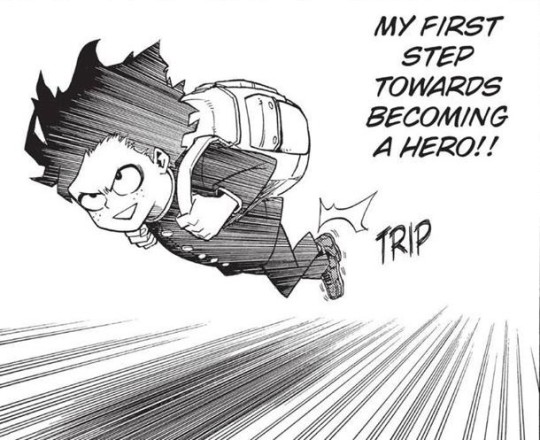
why I like it: I figured we’d start off strong. no point in holding back. can the other panels possibly even hope to compete. maybe. we’ll see.

why I like it: because, you see, he punched a giant robot, and it exploded. you see that, there? and the text was all “SMAASH” in humongous comic book letters, and it was pretty cool. also Deku is very tiny and the robot is very big. and just to clarify, most of the time if a tiny fifteen-year-old child tries to punch an 80-foot robot, it’s not actually going to go all that well, and the robot probably will not explode. but in this case it did! and so this is a very novel and unexpected outcome, which makes it all the more visually striking, which is a very good thing to be when you are trying to show off the brand new superpower which your protagonist just inherited, and letting people see it in action for the very first time.
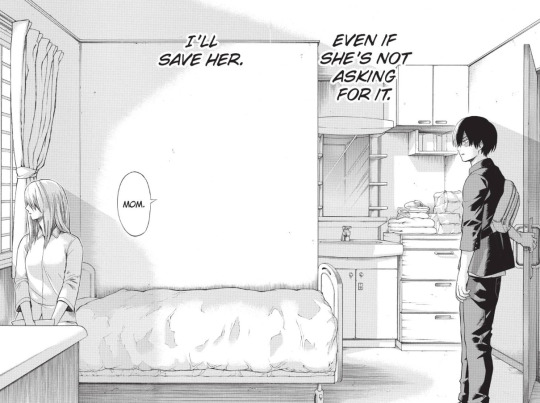
why I like it: so you may have noticed we just skipped a whoooole bunch of chapters lol. this is because there are almost 300 of them, and so I’m going to have to use a bit of discretion. anyway so this is a gorgeous panel. just, everything about it. the lighting; the expressions; Shouto’s hesitation; and his mom facing away, not looking back yet, and us not yet knowing how she’ll react. and the fact that they’re visually separated by as much distance as possible -- at opposite ends of a two-page spread -- and yet they’re so close, closer than they’ve been in years. mm. anyway it’s pretty.

why I like it: first of all because there’s nothing like seeing a deserving character get punched in the fucking face, and few characters IMO have been as deserving as Stain. and second because this is Deku, showing up to save the day out of nowhere at the last minute, because excuse you, but he’s a motherfuckin’ hero. sorry to interrupt your evening plans of stabbing a kid while lecturing him about why, philosophically, he deserves to die. but I’ve got a package here for a Mister Stain. it’s from Mister Smaassh, with two A’s and three S’s.
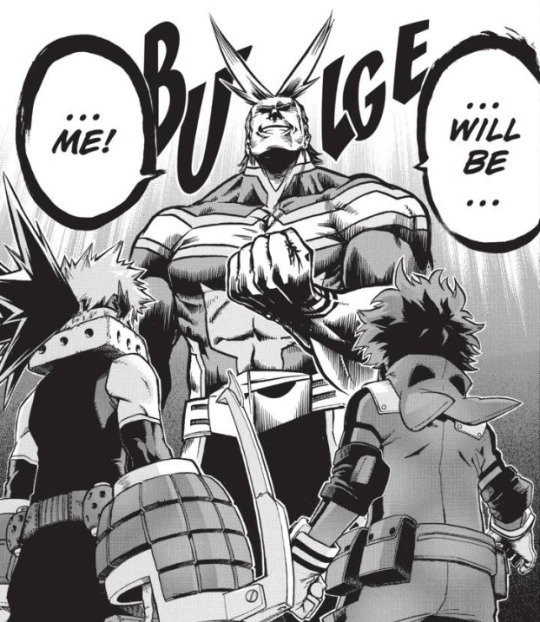
why I like it: fyi, anon said nothing about a cavalcade of BakuDeku panels. you didn’t think I’d let that loophole go to waste, did you? but nonetheless I will try to restrain myself until we get to the second ground beta fight. anyway, I like this panel because All Might’s canonically 7′2″ self looks about twelve feet tall here, and he is just TOWERING over these two boys, who’ve been tasked with somehow outwitting him during this curiously sadistic final exam. and it’s just an interesting perspective, because we know they both look up to him, and here they are physically looking way, way up, up, up at him.

why I like it: now this is how you do a villain entrance. I love absolutely everything about this. the sheer scale of destruction, and the way he’s just sort of casually hanging out there in the middle of the panel almost dwarfed by all this dust and smoke and carnage, and yet is unquestionably the focus of the page. the way that you can’t actually see his face, not yet. not until the end of the chapter. the way the clouds are drifting so calmly and peacefully in the night sky in stark contrast to the horrific events that are about to take place on the ground. this panel gives me literal chills, especially when I think about All for One’s creepy theme music playing in the background.

why I like it: this panel is so iconic to me that it’s one of the first ones I immediately knew I had to go and find when I got this ask. this entire fight is perfection from start to finish, and there are other panels that are more artistically striking if I’m being honest (in particular, the ones where he’s half-transformed with his face perfectly split down the middle between Muscle Might and Skinny Steve). but there’s just something about his determination in this panel, though. something about the fire in his eyes, and the way he clenches his fist. “my heart is still the heart of the Symbol of Peace.” I remember being sooooo fucking anxious when his true form was revealed, wondering if this was it, if the people watching were going to turn on him, if he was going to lose both the fight and their faith. turns out I was wrong on both accounts. basically what I am trying to tell you guys is that this panel was and is still the most badass thing I’ve ever seen.

why I like it: because he’s just a frail old man doing what he can to protect the last flickering embers of the thing that enables him to fight on. there’s something so fucking desperate and yet so determined about this image. he knows it’s futile, but still he persists.
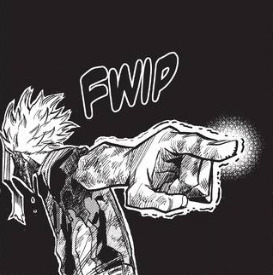
why I like it: damn it was hard to find a “you’re next” panel with just the right angle I like best. this is probably as close as it gets, but I kind of wish Deku was somehow visible in this image as well. but at any rate this is an amazing moment, and All Might is dramatic af for basically no reason but IT’S BADASS. “no I’m not going to actually look where I’m pointing. it’s cooler this way.” or was it because he wasn’t sure if he could keep the emotion off of his face if he actually turned and looked? in this moment of knowing that it was finally over for him, that he would never be the Symbol again, and knowing that he had no choice but to move on and entrust that burden to the next generation? damn.

why I like it: I... fucking... okay, here’s a fun fact. did you know that I still get emotional over this panel almost a full two years after reading it?? obviously a good 84% of it is the context -- All Might losing his power; Deku being forced to take up the mantle before he feels ready; All Might feeling responsible for him; and both of them being so desperately grateful to have each other in that moment. but don’t underestimate that remaining 16% either though! this is just an extremely well-drawn hug, on top of everything else. All Might pressing Deku’s head to his shoulder with his fingers laced in his hair is some mighty fine fiercely protective hug tropes there, you guys. and the way Deku is clinging to his shirt so tightly his knuckles have probably gone white?? while he cries?? while both of them cry? ON THE BEACH? WITH THE WAVES LAPPING SOFTLY AT THE SHORE IN THE PEACEFUL NIGHT AIR?? jesus fucking christ. this hug contains more emotions than I am capable of carrying inside me at once. I just sort of have to let them flow in and out little by little until they finally subside.


why I like it: you bet I skipped right from Kamino straight to Deku VS Kacchan Part 2. no regrets. anyway, so these two panels are an absolutely gorgeous one-two punch. so much has changed from the days when they were innocent little kids marching off into the woods to have adventures. they’ve changed. their relationship has changed. and yet, at the end of the day, Izuku is still willing to follow Katsuki even without being given any kind of explanation. and Katsuki still seeks out Izuku when he’s on the verge of having a spectacular emotional breakdown. because he doesn’t know who else to turn to. and because despite everything, there is trust there still, on some deep, fundamental level neither of them fully understands or knows how to acknowledge. anyway, so these two panels just give me a ton of feels all about the passage of time and how everything changes and how you can’t get back what’s lost, but also sometimes if you look deep enough you find that parts of it were never fully gone.

why I like it: because in a striking display of dramatic main character energy, these boys decided to stage their life-changing destiny-affirming rival fight on the coolest possible stage in the middle of the goddamn night. and then Katsuki made it even better by producing WAY MORE SMOKE than his attack by all rights should have produced! and then they went and crouched down all symmetrically so as to more poetically make intense eye contact at each other. I really like panels with smoke and/or dust clearing dramatically. there are like four more of them coming up on this list. what can I say. it’s cinematic.
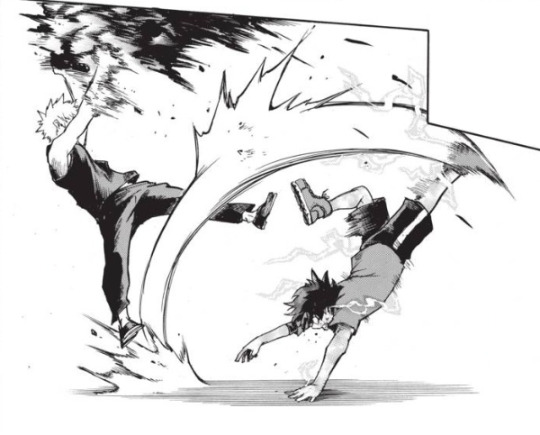
why I like it: I actually had this one as my icon for a while. it’s rare imo to see an action panel that’s so balanced and has so much going on and is so clean and easy to read. both of their poses are so dynamic. I like the way the arc of Izuku’s kick is drawn, and I love the way you can clearly see that Katsuki propelled himself backwards with his quirk in order to dodge it. it’s just a really cool little panel that for me perfectly sums up the general feel of this fight, and its awesome choreography.
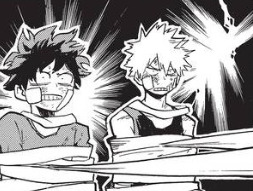
why I like it: actually you know what, before I go any further, let me skip ahead a bit and add three more panels with this same energy.

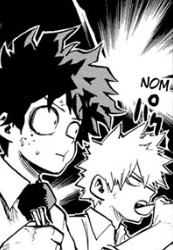
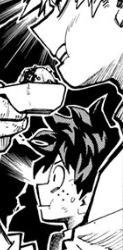
I just really, really love these rare moments when all differences between them are momentarily forgotten and they’re just two teenage boys caught up in the intense pressure of an awkward social situation. the one enemy neither of them is the least bit equipped to handle. anyways Horikoshi clearly enjoys it too because he seems to delight in drawing it over and over and over.

why I like it: because it’s more billowing smoke and dust. because it’s Endeavor, the guy we all swore we would never ever root for, and then 160 chapters later Horikoshi pulls this shit without an ounce of shame. because it’s All Might’s pose, but tweaked juuuuuust enough so that Enji can avoid copyright claims. because he knew that pose well enough to know which arm not to use. because Endeavor is a profoundly flawed human being, wholly incapable of filling the void All Might left behind. and yet he still tries. because it’s better than nothing, and because it’s all he can do. it’s the one thing he can do, his sole redeeming virtue. he tries. he doesn’t give up. anyway so yeah, Horikoshi didn’t have to take the single most unlikable person in the entire manga and give him the world’s most controversial and openly scorned redemption arc. but he did! and I think it’s one of the best things about this entire manga.

why I like it: because nothing in BnHA is just black and white!! it’s messy and layered and complex, just like in the real world. Shouto despised his dad for almost his entire life. with good reason! Enji was abusive and selfish and treated his son more like a prized possession than a person. we as readers are fully aware of all of this, and we sympathize with Shouto 100%, and that’s completely by design. Horikoshi is well aware of this. so for him to still give us this little moment, where Shouto is so relieved that Enji survived that he drops to the floor and presses his face against his hands in this little prayer gesture -- whatever you think it might mean -- is just so fucking powerful, and again speaks to his commitment to refusing to let anything in this series be completely clear-cut and unambiguous. I love that the characterization of Shouto and Natsu hating their dad exists side by side with the equally authentic characterization of them being terrified that they’re about to watch him die. because those two things aren’t contradictory! sometimes that’s just how it is. anyway so this is a beautiful moment of nuance that instantly adds so much to this relationship with just a single panel.
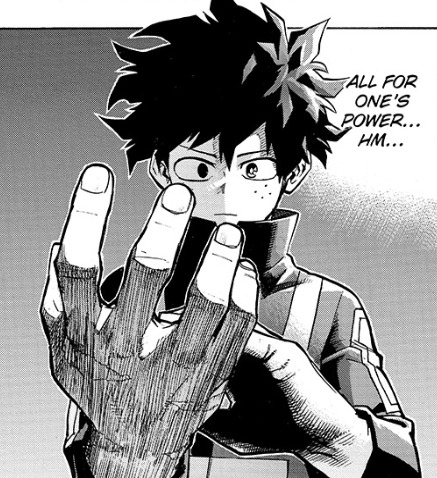
why I like it: for once the symbolism is so obvious that even I can’t fail to miss it! Izuku’s face half in light and half in shadow as he thinks about the power bestowed on him. “All for One’s power.” anyway so in my mind Izuku having AFO could not be any more fucking foreshadowed if he was wearing a freaking t-shirt with the Musketeers saying on it and the background was peppered with little Sistine Chapel-esque images of AFO giving his quirk to his brother lmao. but regardless of how it does end up playing out, this is nicely done.
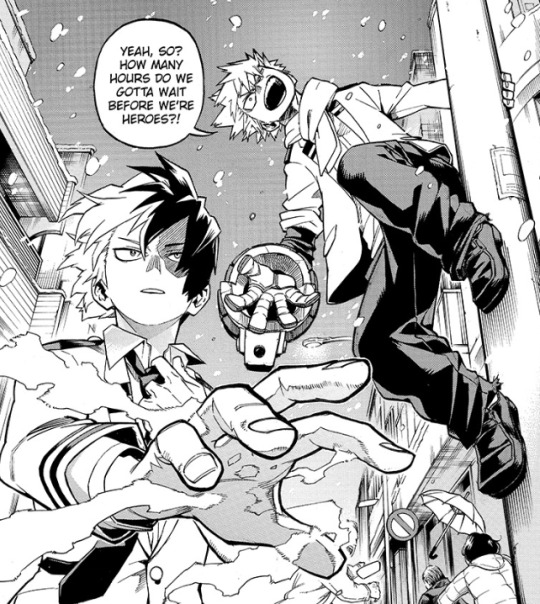
why I like it: I wasn’t sure whether I should include this image, given that I just made a whole separate post about it a few days ago. but I just really like it, okay. this is one of the all-time great entrances in the series. Bakugou being perched on that pole for absolutely no reason other than to add visual interest. Todoroki’s hair blowing dramatically in the wind. Katsuki’s frayed pant hems and characteristically asymmetrical facial expression. the fact that you just know both of them spent the ride home with their faces pressed to the windows of their taxi cab hoping desperately for an opportunity to break in their brand new licenses, and then lo and behold. that’s amazing you guys. it’s almost like you’re main characters or something.

why I like it: they did great.

why I like it: because I lost my fucking shit at this fucking reveal and can you even blame me?? we knew coming in how much trouble Endeavor and Hawks had dealing with just one of these Noumus, and then Horikoshi goes and divulges that the villains have at least A DOZEN MORE waiting on standby. including Hood right there in the foreground, which is a fantastic touch! this panel, for me, almost instantaneously established the League as a legitimate threat once again, and gave me the kind of spine-tingly evil vibes I hadn’t felt since the Kamino arc. and while the payoff might not quite have lived up to my expectations, the Mirko fight at least was more than worth it.
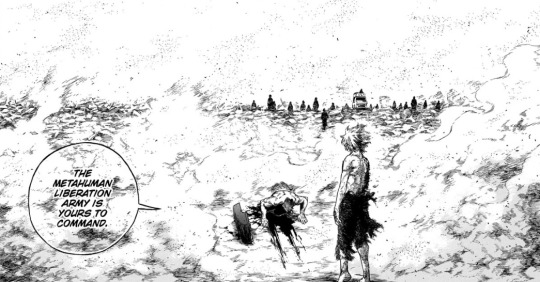
why I like it: BILLOWING SMOKE AND DUST CLOUDS. you just see this vast landscape of destruction that Tomura has oh-so-casually wrought, and this once-powerful enemy utterly defeated on his hands and knees bowing before him. and it’s just like, oh. Tomura just became a fucking king, didn’t he. he finally stepped up and became the main villain. really the main villain, not just an awkward fumbling NEET whose adopted dad is not-so-secretly pulling all the strings. he did this himself. he went out and conquered and Awakened and won himself a fucking army. and he’s just standing there so cool and casual in the aftermath of it all. and then he goes “oh wait, you guys have money right, that means you can buy us the good sushi.” yes, Tomura. yes.

why I like it: um because this panel is fucking amazing?? hello?? do I really need to explain this one. the detail is jaw-dropping. he’s got the little scars which are either from the head wound that caused his death, or from his Noumufication. his expression is fucking heartbreaking, and the transition from Kumo to Kuro is so subtle and seamless, and yet it distinctly is both of them. this panel is gorgeous and fucking haunting and almost made me gasp when I first saw it.

why I like it: the decision to have the night sky take up so much of the space in the panel was [chef kiss]. nothing says existential like the night sky on a cold winter’s night.
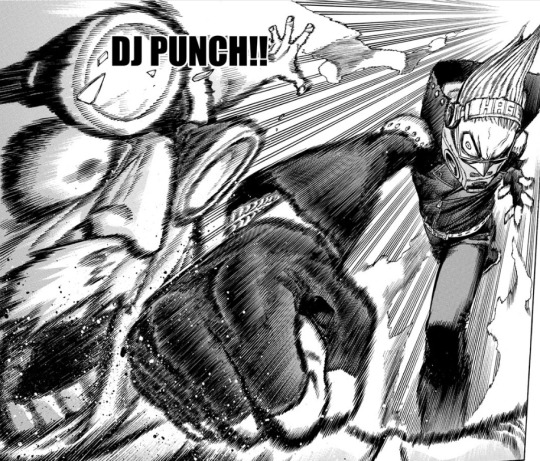
why I like it: this is the best panel in the entire fucking series.

why I like it: dude. showing his actual family holding onto him with their hands in the same spot as the severed fashion!hands was a stroke of genius in and of itself. but combining that with the emotional tension of them desperately trying to hold him back and protect him from AFO?? that’s just so fucking smooth it’s almost inhuman. just how much meaning can you cram into a single image?? sometimes I wonder just how far in advance Horikoshi plans these things.
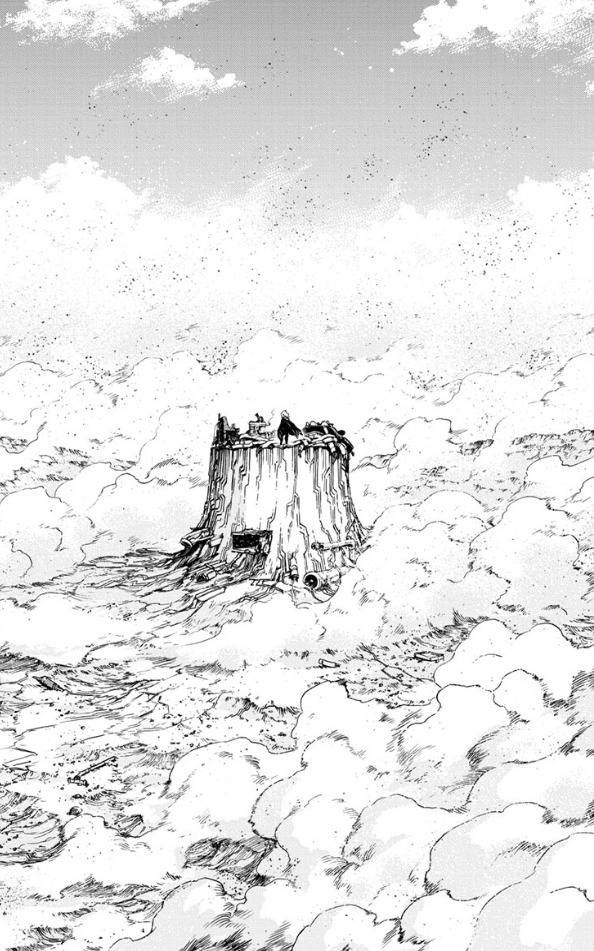
why I like it: guess I’m just a big fat sucker for panels of Tomura calmly standing around in the ruins of his own senseless destruction. the sense of scale on this one is really great, too. and yet again, those dust clouds. gotta love it.
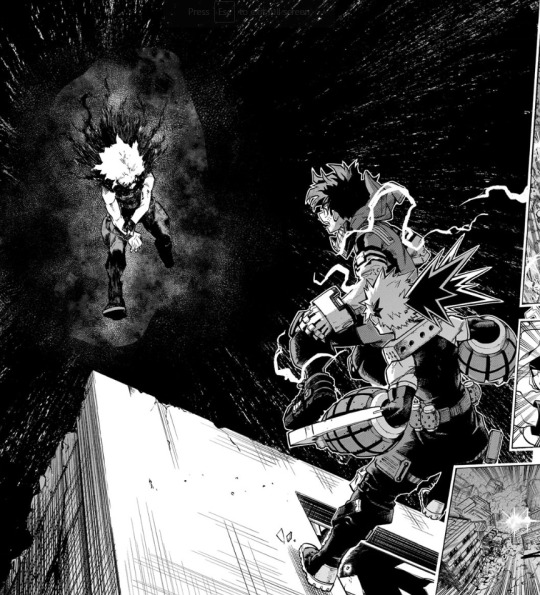
why I like it: because Tomura literally appears out of nowhere, like he’s ripping a hole through the fabric of time and space. it’s so fucking sudden and he looks evil as FUCK, and Deku and Kacchan are totally caught off-guard, and it is scary. this is one of those panels that made me say “holy shit” out loud. in fact I practically screamed it. and the angles are all funky and weird, and the sky is all BLACK FOR NO REASON, and it really just feels like Tomura could reach right over and just MURDER THEM like it was nothing. just like that. this panel is so incredibly effective at conveying how hopelessly outclassed the boys are. they’re not even in his league, and it’s honestly terrifying.
and on that happy note, we have come to the end of my list of favorite panels! and I gotta say, it’s really gratifying that a good deal of them are from this year alone. I said it in another post a few days ago, but imo the overall quality of the series has been insanely high as of late, and it honestly just blows my mind whenever I stop to think about it. the art is still this good six years into the game. the story is still this good. we are spoiled goddammit.
#bnha#boku no hero academia#midoriya izuku#bakugou katsuki#all might#endeavor#todoroki shouto#shigaraki tomura#horikoshi kouhei#bnha spoilers#mha spoilers#makeste reads bnha#asks#anon asks
85 notes
·
View notes
Note
RE: WIPs game: do I even want to know what Dicebenders is is it another scam how many times are the Gaang gonna get arrested for scamming
No, this time it's me scamming people. XD The dice in question are the RPG Dungeons & Dragons kind.
For a while I was doing a screencap webcomic in the style of "DM of the Rings" and "Darths & Droids" with another creative fan named Captain Boomerang. I was the scriptwriter and selected the screenshots for each panel, and Capt-BA would assemble the comics and improve my scripts (a process that did frustrate me a little, as I felt locked out of the revision process, but I did like the results. I just felt like I wasn't holding up my end of the partnership a bit). I wrote a story bible explaining the characters and storytelling rules, planned out the adaptation of the entire AtLA premiere, and had less detailed plans for the rest of the series, but we only got 6 comics in before Capt-BA went on a trip and never returned to the internet. I did manage to re-establish contact with her long enough to get permission to continue the comic, but the problem is that I have no image-editing skills whatsoever.
If I could find comic-making software that I know would do what I want and be easy to use, I wouldn't mind dropping some money on it, but everything I've looked at is trying to do lots of things I don't need. I only want a way to import existing pictures into comic grids, and then easily add dialogue bubbles. That's it. But the stuff I've found is more about image-editing than comic assembly, and it takes me an hour to put together a dialogue bubble that looks good. So I have 3 scripts that were never produced, which along with the planning docs are what's in that WIP folder, and I don't ever see myself going beyond that.
Besides, someone else already managed to complete something like this, and while I'm not a fan, I don't need to be. At this point, Dicebenders is dead. I'm glad I tried it, and it's a shame it didn't work out, but I'm happy with the other projects I've done instead.
I am squatting on an empty Tumblr for it, though.
Anyway, to share something new, here's the first section of the Story Bible I wrote to make sure Capt-BA and I were on the same page in terms of characterization. The rest of the bible details the plotlines for full series.
AVATAR: THE LAST DICEBENDER
BIBLE
Premise- A small group of players attempt to run a fantasy martial arts RPG that winds up essentially becoming the Avatar saga, or something very close. The main point of the series is comedy, based mostly on ridiculous links between Avatar and RPG's. Sometimes the humor will be in the vast difference between what happens in the comic, and what happens in the cartoon with the same screenshots. Other times, the funny will come from the unexpected ways they converge.
SPIRITUAL PREDECESSORS
DM of the Rings- The original, and my personal favorite. It's a good showcase of how to run a single quest together, while using narrative jumps to skip to the good bits.
Darths & Droids- A similar project, this stands out from its predecessor in two main ways. The players and GM are more friendly with each other, and are more or less having fun with each other. There is also a running, coherent storyline in both the game and in the lives of the players.
Benders & Brawlers- This is actually an existing attempt to do Darths & Droids with Avatar. This is helpful as an example of what we DON'T want to do, retell the Avatar story in a completely straightforward manner, with RPG players behind the characters.
CHARACTERS
None of the characters will be given real names. The players shall always be referred to by their character names, although this can be done in a teasing, ironic manner. When the characters are speaking, their dialogue bubble must always be attached to an image of the character.
The Gamemaster- The GM is a female in her early teens. She is a geek, and a bit of a social outcast for it. Nevertheless, she's trying to make that work for her, although she's not quite mature enough to make it happen yet. She has just discovered RPG's, and in her enthusiasm has gone all out in starting her own campaign. The only problem is that she doesn't know how to recruit players, so she ropes her best friend and little brother into playing with her. This is the GM's first campaign, so she'll a little in over her head. She knows the mechanics of play, and what she's supposed to be doing as GM, but doesn't have the fine skill in crafting an engaging RPG experience. Still, she wants to do her best, is willing to learn, and has a positive attitude about the whole thing. The GM has a strong crush on the Sokka player, but the only way she can express it is by having all the female NPC's flirt with the Sokka character.
Katara- Female in early teens, and the GM's best friend. Katara's player was friends with the GM from when they were both in grammar school, so while they have grown up into wildly different personality types, they are fully loyal to each other. Katara is popular, and outgoing, and doesn't care or know about geek stuff at all. She's only playing the game because the GM begged her to. At first, Katara is clueless about RPG's, and frequently questions or ridicules the mechanics of the game. She never quite gets into the idea of role-playing, but quickly takes to the idea of meta-gaming. She'll have her character act like a righteous do-gooder, because completing missions and fighting bad guys earns XP. She hoards items that will boost her stats. She'll advocate abandoning a mission/plot if it doesn't pay out enough rewards. Katara's player also can tend towards trying to Mary Sue her character, but this is inconsistent and usually shot down by everyone else.
Aang- Male in junior high, and the GM's little brother. He plays simply because his sister has cajoled him into it, and there are hints that he's getting some kind of reward or payment for it. He abuses his position by forcing the GM to give him what he wants in the game, even if it breaks the rules- access to the restricted Airbender class, the ability to bend all four elements, overloaded stats, an Avatar State that protects him from dying, a magic super flying cow ride, etc. However, it's important to note that Aang's player isn't a jerk. He's just immature, and like all kids, just always goes for what he wants via the easiest path, and doesn't realize that he may be causing trouble or hurting feelings. He's enthusiastic about trying out this RPG thing, but he has trouble coming up with any action beyond attacking or retreating. He's also hyper aware that the GM and Katara are girls. He is too old for cootie concerns, but thinks that girls are fundamentally different creatures with their own incomprehensible concerns. Having a big sister, he doesn't find this a big deal, just part of life. Aang's player is too young to be a geek. He likes cartoons and sports and fantasy and school-dramas. He also tends to follow whatever his sister likes.
Sokka- Male in late teens. This guy is your quintessential RPG player. He has is own top-quality dice, he's played campaigns and systems of all kinds, and knows the tropes of the hobby cold. He's a huge geek for all things geeky, but roleplay is easily his favorite. He's a social outcast, but he's made friends among his fellow geeks, and thinks life is just fine. Sokka's player joins when he meets the GM at the comic/games shop they both frequent. The GM was buying some sourcebooks and material to support the fantasy martial arts game she's running, and Sokka noticed, asked about it, liked what he heard, and got permission to join the game. What Sokka doesn't realize, because he is a geek and neither has experience with it or realizes it's even possible, is that the GM is sweet on him. This manifests in the character Sokka's canon luck with the ladies, only kicked up a notch. *Every single* female NPC flirts with him, whether it's appropriate or not. Sometimes player Sokka notices and tries to roleplay it, and sometimes he's just plain confused. Sokka has a few quirks. His best set of dice are his Lucky Red Dice, which always roll high when he needs it, but have been tested and proven to be fair dice. He also mandates that every character he plays use a boomerang; he was turned into a geek by the first video game he ever played, a Legend of Zelda title, and his favorite weapon from those games are the boomerang. Each of his characters has a unique, named boomerang.
Zuko- The GM's favorite NPC. She created him to be a compelling, dramatic character, with a complicated back story, moral struggles, badass loner personality, angst about his existence, a darkly noble quality, and a cool scar. The GM intended Katara to get to know Zuko, for her to try to woo him away from the side of evil, and perhaps to even have a romance with him. The PC's, however, couldn't care less about him. To them, he's just another mini-boss, and the fact that most of his character development is happening "off screen" means they don't realize that he's recruitable. A frequent gag is Zuko delivering a stirring monologue while no one pays attention.
Iroh- Background NPC. The GM tries to use him to give (ignored) hints to the players.
Toph- (tentative) A male munchkin gamer who picked a long list of weaknesses in order to get superbending. Toph's player is a friend of Sokka's player, brought in after an "incident" with his old group, and causes some initial resentment in the group when tries to show the n00bs how its done. Cowing Toph's player is a major victory for the GM.
Momo- NPC, but maybe make him a talking sidekick who gives the players hints when the GM is really exasperated?
Azula- the GM's best favorite villain. Azula is the GM unleashed, letting her take out frustrations on the players in both combat and harsh taunting. Eventually the GM comes to like the character so much, she retcons mental health issues into the character's backstory, and has her pet NPC, Zuko, spare her.
8 notes
·
View notes
Photo

Liz Bourke Reviews The Witness for the Dead by Katherine Addison
The Witness for the Dead isn’t a sequel, focusing as it does on an almost entirely different cast of characters and set as it is far away from the imperial court. But despite its altered milieu, it has a similar flavour, with an intimate, personal emotional register and a thematic concern with duty and ethics, loneliness and connection, choices and consequences.s Sarah Monette, Katherine Addison has written a tetralogy (Mélusine, The Virtu, The Mirador, Corambis) and co-written a trilogy with Elizabeth Bear (A Companion to Wolves and sequels), but she is best known for the award-winning The Goblin Emperor (2014), a novel about an isolated young man who succeeds unexpectedly to the rulership of an empire; about his loneliness and his struggle to do right by his responsibilities, his role, and what remains of his family: a struggle to be a kind man and an ethical emperor. Fans have long awaited a sequel, or at least another volume in the same universe, and The Witness for the Dead does not disappoint.
Readers of The Goblin Emperor will remember Thara Celehar, the shy and retiring prelate of Ulis to whom the emperor Maia (reigning as Edrehasivir IV) turned to investigate who killed his father and half-brothers. Celehar, though successful in his commission, took no delight in it, nor did he really want any tangible reward the emperor could offer him. Now he resides in Amalo, a provincial town best known for its airship industry, in an awkward position – neither fish nor fowl – with the city’s religious hierarchy, followed by politics but wanting no real part in them.
Celehar’s gifts and talents make him a natural Witness for the Dead, for he is able to communicate, in some fashion, with the shades of the recently deceased, and the role of a Witness for the Dead is to be their advocate. His decency and fundamental honesty – and his kindness – means the work takes a toll on his spirit. Celehar comes across as a man who’s haunted, in more than one sense of the word, and one who feels his duty keenly: he wants to be useful.
When the body of a young woman washes up in the river, Celehar’s duties include finding out who she is and investigating how she died. When it turns out that someone killed her, part of his role becomes finding the murderer. This leads him into Amalo’s opera scene, where it transpires that the young woman was greatly disliked, and into the business and secrets of a high-strung opera company and its very personable manager.
This investigation isn’t the sum total of Celehar’s duties, even if it is, at the moment, perhaps the central one. Witnessing in the case of a disputed will causes political problems that see him sent out of town to deal with a ghoul problem in the countryside in the middle of his investigation. On his return, his honesty and calling are questioned, and he is forced to prove himself by ordeal. And searching the cemeteries of the city for the grave of a distraught man’s sister – buried by a husband who cut her and her newborn child off from her family – leads him to the discovery of a series of murders.
Part of the appeal of a murder mystery – and The Witness for the Dead is very much a murder mystery – especially a historical or a fantastical one, is the exploration of the world, the piece-meal revelation of how things fit together, or don’t fit when they should, that is the context of the mystery. The most common failure mode of a fantasy mystery is when it lacks the depth of world, the depth of field, to offer a rich background and a rich foreground into which the red herrings, deceits, and diversions can fall. That is not a failure to which The Witness for the Dead is susceptible. Addison’s prose breathes life to a world full of details, a world that makes sense – socially, culturally, in its contradictions and nuances – in itself, which we see through Celehar’s eyes. His assumptions about how the world works, and about how the world views him – his poverty, his painful humility, his… shyness or loneliness or both – are only mostly true, and the details give us perhaps a more rounded picture, at least of him, than he himself notices. Amalo is a city with as much character as a real place, as intricate and as believable as London, Paris, or Hong Kong.
In other hands The Witness for the Dead might come across as a noir or as cosy, but as a mystery novel it’s not easily slotted into either category. Like The Goblin Emperor, it’s fundamentally humane, sensitive, and kind. Celehar is a compelling protagonist, and as always, Addison gives her characters striking and engaging voices. The Witness for the Dead is an accomplished and enjoyable novel, and I believe fans of The Goblin Emperor will find much to delight them here.
3 notes
·
View notes
Text
Denki Kaminari is the traitor and I can prove this through his character design
I actually wanted to analyze all of the character designs of class 1-A, but this theory has been burning in the back of my head for weeks, so now I’m doing the shortened version with just looking at Denki’s part. Hey-ho let’s go.
1. Lists
First off, we have to create an analytical basis. In my opinion, the students of class 1-A can be separated into 4 different categories in regard to their overall “importance” to the story (I know that sounds rude and I personally hold all the kids very close and dear to my heart, but from a storytelling perspective you got to admit that there are some characters given less screen time or story beats than others and as a result tend to be less important than characters who have lots of flashbacks etc.). The categorization is based on an objective view of the series and I will try to explain why I put certain characters in certain categories along with naming the categories.
1) prime primary characters (100% not the traitor)
Deku, Bakugou, Shouto
These three are the main focus of the series, the protagonists if you will. They get the most screen time, the most flashbacks, and the most backstory information and are untouchable pillars of the story’s groundwork. All two (or three) of them have their own personal character arcs that span longer than just one story arc (see Bakugou slowly learning not to be an absolute gremlin, Deku’s long journey of becoming the hero he wants to be, Shouto learning to deal with his father’s abuse and family situation). Even if you’d say that i.e. Shouto is not important enough to be counted as one of the protagonists, he is still one of the most recognizable characters of the series and definitely on the forefront when it comes to fleshed out characterization.
2) primary characters (70% not the traitor)
Ochako, Tsuyu, Iida, Kirishima
These four characters are the main group surrounding the protagonists and are fundamental as the supporting cast. These include the first two real friends Deku made at UA, Ochako and Iida, as well as Tsuyu and Kirishima. Ochako is here because of her connection with two characters from the prime primary category: she is one of Deku’s closest friends in addition to being clearly framed as his main love interest, as well as being in one of the more important fights from the Sports Festival against Bakugou. Iida is connected to two characters from prime primary as well: like Ochako he’s close friends with Deku, but also shared a lot of spotlight with Shouto during the Stain storyline. Kirishima seems to be only connected to Bakugou at first (being the first one to try to befriend him, reaching out to him during Kamino, being reminded of his strength through Bakugou during his own backstory flashback), but with the recently finished Overhaul arc in the anime he also had his time to shine alongside Deku during that arc. Tsuyu was a bit of a tough case to categorize as she did not have any flashbacks or bigger story arcs for her own (yet), but she is also one of those closest to Deku and did share an emotional moment with him and Shouto after the Bakugou rescue mission. She is also a very recognizable face for the series (so much that my friends who have never touched a piece of BNHA media named her as one of the characters they think are in the series “there’s the protagonist, then this boy with the split hair colours and...That weird frog girl, right?”). Characters in this category have backstory and flashbacks like those from the prime primary category, though these are dealt with and then accepted as a staple in the story, and not ongoing plot structures. Examples for this are the mention of Ochako’s motive for becoming a hero, Iida’s revenge plot and Kirishima’s backstory during the Overhaul arc. These are important story beats that flesh out their characters, but once the arc reaches its end the character growth for the character in question slows down a lot or comes to a halt entirely. Counter example is Bakugou’s ongoing character growth throughout the series, which will remain as an arc throughout the whole thing because of his status as prime primary character. If one of these characters were to be the traitor it would not be a series destroying move, though in my opinion it’s still very unlikely, since these all have proven themselves to be close friends with the prime primary characters, shared emotional moments with them and gave us all a look into their motivations and backstory to a point, where I just think it’d be highly unlikely for one of them to do a 180 and turn out to be ‘evil’. For those already typing that that’s the point, that we should think the traitor is not this close to the protagonists to then be surprised by the reveal, I have to tell you that that is not how story-telling works. If you put a character in a story, make them best or very good friends with the protagonists, make them save and/or help them during tough situations, make them have flashbacks to their own childhood or develop backstory with the prime primary characters by their side, and then reveal them to have betrayed them the entire time without setting it up beforehand, you are not a good writer. Neither Iida nor Ochako nor Kirishima nor Tsuyu have had a situation in which they did or said questionable things or acted in a way that would make one stop for a moment and think about what just happened. They also all have a very high recognisability for the series and turning one of them ‘bad’ would be way too ground breaking for BNHA. (I know that Hori likes to subvert shounen tropes and such, and I admit that he manages to surprise me a lot, but he still largely follows the main story beats, plot structures and character functions other shounen writers before him did, so I assume that he won’t pull the reverse Uno card and make for example Tsuyu the traitor, because that simply goes too much against the current of shounen and other media of the type).
3) secondary/support characters (very likely to be the traitor)
Mina, Kaminari, Aoyama, Tokoyami, Jirou, Momo, Sero
These characters are sort of there to fill the classroom, but are designed and set up in a way to potentially have backstory and character growth. These are characters that have had small arcs mostly connected to the prime primary and primary characters that weren’t really that in depth or emotional, but are a great set up for more growth. One of them is most likely to be the traitor in my opinion because they kind of stand in the middle: they are recognizable for the series (see for example Mina, Tokoyami, Jirou) and have had short touches with backstory (see Aoyama talking with Deku about him not being compatible with his quirk, Mina having a small part in Kirishima’s backstory), or character development (see Momo showcasing her skills during Joint Training, the current small arc in the anime of Jirou learning to save people through music), but are ultimately kept in the background. To sum it up, they are very clearly meant and designed to be secondary to the main cast of prime and primary characters.
4) full-picture characters (too unimportant to be the traitor)
Hagakure, Koda, Shouji, Ojiro, Sato, Mineta
These are characters which are in my opinion very clearly designed to “just” be background characters, or as I call them “full-picture” characters (in the sense of them filling empty spaces in a class picture). This does not mean they will never get any development, though they are very likely to stay in the background and act as very minor supporting characters to prime and secondary characters. These characters are designed to be very simple and often have a constant joke that goes with them (see Mineta being a pervert, Ojiro being plain) and are meant to create a basis for interactions between prime and secondary characters. They are literally too unimportant to be the traitor, meaning if it was suddenly revealed to be one of them, there’d be no screen time, no real dialogue and no backstory to back it up (up to now). Characters can move from this category to the secondary character category, though this is currently still unlikely.
Possible spoilers from here on out!
2. Look at these characters and tell me their personality
Ok, now that I’ve categorized all my precious hero kids into their story-level importance, I think it’s time to point out something that hit me yesterday at 1 AM: I noticed that the more important a character is for the series, the more ‘human’ their character design is. I’ll try to explain: in the world of BNHA it’s very common to have a sort of ‘mutated’ body, most times to accommodate for a quirk, though sometimes the mutation seems a bit random. However, the series is filled with people who have multiple body parts, highly deformed body parts or otherwise bodies that deviate from the to us normal human form. Now let’s look at our kids and their importance levels: all the prime primary characters have completely ‘normal’ human bodies (btw, single-colour colourful hair will not be counted as deviating from the normal human form, this is still an anime we’re talking about). They are all average heights for boys their age, no extra body parts, no deviation from an average anime boy face. Yes, there’s Shouto with his two-coloured hair and two-coloured eyes, but the split only applying to his hair and eyes makes him still look very much like an average human, as opposed to i.e. if his skin was also two-coloured and split in the middle. I think it’s not that surprising for the three main characters of a shounen to look like normal teenage boys, since it’s still a series meant to appeal to a widespread audience and I don’t think that could have been achieved if Deku and his two prime buddies were all heavily mutated. For now, let’s look at the primary characters: Ochako is very humanly designed, no weird mutations or crazy design elements aside from the pads on her finger tips. Iida is also very human, no deviation from the norm in face or body aside from his engine pipes in his calves. Kirishima also looks like the average anime boy, the only time he looks rather ‘inhuman’ is when he fully activates his quirk and goes into Red Riot Unbreakable. Tsuyu is the only one out of the primary characters whose body and face deviate more heavily from the normal human form (though the deviation is also not that crass or remarkable). And what did I say while categorizing her? She is tough to categorize because she hasn’t played that big of a role in the story yet, that she had a few emotional moments with the prime primary and primary here and there, but ultimately she does not have a backstory or major story elements yet. This stands in contrast to Ochako, Iida and Kirishima, who have all had major story beats, flashbacks and important interactions with the prime primary up to now, and are all very much humanly designed, aside from minor deviations that don’t affect their overall picture. Compare Tsuyu constantly standing a bit hunched over, her big feet and hands, her comically large eyes, her large and uniquely drawn mouth and her tongue sticking out to Ochako, who looks like an average anime girl except for the small pink pads on her finger tips.
Hold on. From the 7 characters in the prime primary and primary category, only one deviates a bit more from the human form and coincidentally that one is also the one character out of the 7 who has not have major character growth, backstory, flashbacks and/or the kind of specific interactions with the other characters from the categories yet? Now I’m intrigued. To me it seems the more important a character is for the series, the more human is his character design.
And now, to ask the question we’re all here for: if Hori did not scrap the traitor plotline, wouldn’t it make sense to make the traitor as human as possible? Since the possibility of a traitor was treated very serious during and after the UJ incident, as it posed a threat to the security and well-being of UA, I figured that whoever the traitor is shouldn’t look too, or be connotated with the words ‘joke’, ‘inhuman’ or ‘silly’. Not only would it make the most sense for an average, human looking student to be the least suspected, but it would also make the story-wise hit and drama from a traitor reveal that much more captivating, both for main characters and audience, since then the traitor is not someone they are completely detached from look wise, but someone who looks very close to them or someone they know. If the traitor were to be a student with blue skin, a trunk and six legs, I think it would just take away from the impact of a reveal and make you wonder why nobody noticed the questionable actions of the literal alien.
Since I think we can all agree that the kids in the prime primary category are 100% not the traitor, and the kids from the primary category are also very much not likely to be the traitor because of their major involvement with the protagonists (and the absolute bullshit it would be to make the characters who were established since page 1 to be nice and helpful turn to the bad side without beforehand character development in that direction), that leaves us with the kids from the secondary category and the kids from the full-picture category. The latter I described as being designed for the background; characters who could potentially rise in category once given character development, but who are without backstory or character growth up to now. Let’s look at them: Mineta, Sato, Ojiro, Shouji and Koda all deviate heavily from the standard human form set by the prime primary characters, either by their body size, mutated body parts or facial deviation. As much as it pains me to say this, they are all designed either too far from being ‘normal human’ to be the traitor, and/or have a joke attached to them and their character that would make a possible reveal come off as too comedic or inappropriate. Hagakure is a special case. She has deviations from the human form (having no visible body) but this is a minor deviation compared to the other five in the category. Still she has a joke attached to her (not being visible) and is also kept in the background of the series without having major story beats on her own and, like the other five, acts more as a supporting character to the secondary characters. Overall, the 6 kids in this category all have heavy deviations from the standard human form and a joke attached to their character, which makes them very unlikely traitor material.
Let’s look at the secondary characters in more detail: without revealing too much, the characters in this category are design-wise on the same level as those of the primary characters with very minor bodily deviations from the human form and only some of them have a joke attached to their character. Mina and Tokoyami have the most prominent bodily deviations with having pink skin/horns and a bird head, but let’s take a look at their role in the overall story: Mina is very much a Genki Girl, an enthusiastic bouncy girl, and acts as a support especially to Ochako and Tsuyu. She also played a semi-important role in Kirishima’s backstory, which let us have a look at her childhood/middle school self. That, plus her deviating human form makes it clear: a character like her is very unlikely to be the traitor. Tokoyami has a more severe deviation from the human form, plus he has a semi-joke attached to his character (constantly being serious or dramatic, holding speeches about darkness in archaic language). He also got captured during the Training Camp incident and is friends with Deku since the Sports Festival. Deviating human form, constant joke connotated with character, taken advantage of by the villains: in my opinion, very unlikely to be the traitor. Two characters in this category with very little deviation from the human norm are Jirou and Sero. Jirou has her earphone earlobes as the only deviation, while Sero has his elbows and almost constant big-toothed smile as his bodily and facial deviations. Jirou is one of the counterparts to Mina’s Genki Girl type and also acts as a supporting character for the rest of the girls. While Ochako, Mina and Hagakure can be characterized as enthusiastic, bouncy and happy, Momo and Tsuyu are more of the intellectual and tactical types, with slight tendencies to get bouncy when excited. Jirou is a middle part among the girls, being cool and reserved and not as bouncy as Mina, but also being slightly more brash and offensive than Momo or Tsuyu. She has no real joke attached to her character, but the fact that we have seen her parents and the recent arc in the anime is all about her realizing she can save people through her music (overall being a more light-hearted arc) add to my opinion that she is very unlikely to be the traitor. Sero has his elbows and smile as his deviations from the standard human form and as a member of the unofficial ‘Bakusquad’ he serves as a supporting character to Bakugou, Kirishima and Kaminari. There is no joke attached to his character, but sadly there is also not much more to his character up to now. He’s had minor roles in the Sports Festival and Training Camp Arcs, and often acts with Kaminari as a duo, but compared to him, Sero has had very little overall screen time, very little meaningful dialogue and almost slides off into the full-picture category. The only reason I did not put him in that category is because of his only minor human deviations, but overall he just is not prominent enough in the story to be considered for the role of the traitor. That leaves us with two characters with absolutely no deviations from the human form and one with slight facial deviations, the latter of which is Aoyama who has a very unique facial design among the class. He also has constant jokes attached to his character, one being always looking into the “camera” and breaking the fourth wall, the other being often talking about his fabulous self and acting out in bizarre ways. Another point that paints him very unlikely traitor material is his recent small arc in the anime: starting out with ominous signs towards Deku and acting more weird than usual brought many to the conclusion of Aoyama being the traitor, but as it turns out he was used as bait. The real background for his weird behaviour was him telling Deku about his own quirk, Navel Laser, not being compatible with his body, which is why he needs his support belt. Him and Deku form an emotional bond after this and Deku considers Aoyama his friend from that point forward, and after this incident, Aoyama returns to his usual (though still bizarre) behaviour. If Aoyama would be the traitor character, all the character clues, small flashbacks and emotional development that led up to his scene with Deku would have to be repeated and changed to form the basis for the traitor characteristic. As this is very unlikely to be the case, and Aoyama has had his small brush with character growth, also not forgetting the jokes attached to his character, I think it’s overall given that he will not turn out to be the traitor. That leaves us with Momo and Kaminari.
Momo has no human derivation to herself, as well as no joke attached to her character. She has had small encounters with character growth during all the exam arcs as well as in Kamino, which also sort of is the breaking point for traitor theorists with her: During the attack on the training camp she created a small signal device and got Awase from 1-B to attach it to the villains. This signalling device would later help the Bakugou Rescue Team she was also a part of help to succeed on their mission. There was no need for her to create that device and/or join the rescue team if she was the traitor. I mentioned that there are no jokes attached to her character, though that is not entirely true. There is actually one joke that is sometimes applied to Momo, though it is not constant or particularly deprecating: it is her upbringing as a rich girl, which sometimes makes her detached from the monetary struggles her classmates go through, though this is more treated as a quirky characteristic than a joke. In regard to her being rich, she also invited some of her classmates to her house to study in Season 2, which gave us a look into her home. All the above mentioned facts speak against her having traitorous tendencies, despite being the only complete standard human girl.
3. The Case for Denki Kaminari
That leaves us with Kaminari Denki, the only boy in 1-A other than some of those from the prime primary and primary categories who 1) has absolutely no deviation from the standard human form, 2) has no constant joke to his character (we’ll talk about his whey in a second) and 3) has enough interaction with characters from both prime primary and primary to almost be considered a primary character. He really looks just like the standard human boy looks in BNHA; the only thing making him stand out look-wise is his hair, which is styled slightly spiky and has the black lightning bolt on his bangs (which is btw not dyed but there since his birth). His trait of ‘being flirty’ is as minor as Momo’s rich girl tendencies and also treated more as a characteristic and not as a joke. Now, I know you’re all pointing to his whey right now. Whenever Denki overuses his quirk and releases too much electricity it fries his brain and he goes dumb for about an hour, sticking up his thumbs, making a dunce face and only being able to talk very slurred. But is this really a joke? Is it not more a supposed additional characteristic of his quirk? Because if you think his whey-phase is a joke, then Tsuyu hibernating when it gets cold is also meant to be laughed at and Momo going tired after creating big things as well. Not to mention that, as many have mentioned before, his whey is something very easily fake able. But let’s jump back to his hair for a second. I know, it’s the most minor thing one can talk about, but isn’t it strange that Jirou and Denki are the only ones out of 1-A other than Shouto who have two-coloured hair? And people have been brushing this off, but the two-coloured hair is like, a major character trait for Shouto and not only represents his two sides and his two quirks, but is also symbolic for the split he feels inside of himself and the colours are representative not only of his parents’ hair, but also of the quirk each side can handle. So why can’t it be symbolic for the other two? Putting Jirou aside, what does the black lightning bolt-like strand in Denki’s hair represent? His quirk? Very plausible, since his quirk is based on electricity. But why is it black? You see, Jirou has a small ECG line in her hair, which is also representative of her quirk (and maybe of her hidden emotional and passionate side), but its colour does not deviate much from her original hair colour (her normal hair is dark purple, the line is light purple). Denki could have had a lightning bolt-like shape in any colour in his hair; he could have even had his hair completely black and the shape in yellow to emphasize it, but he doesn’t. He could have had a completely different hair style, with his hair being styled wildly in all directions away from his head to be symbolic of having an electric shock for example, or his hair having multiple small lightning bolts in it, but he doesn’t. Why is his hair completely blonde, except for the small shape symbolic of his powers in pitch black, almost lying like a dark shadow on the bangs slightly obstructing his face?
Moving away from the hair: if he is really meant to be a rather jokey secondary character with no important backstory, character development or role in the series, why is he designed so humanly and close to the protagonists? He could have had the constant whey-look on his face, be very tall and lanky to resemble a lightning rod, have the before mentioned ‘shocked’ hair-style, have lightning shaped markings on his skin, have antennas on his head that act like TV antennas; he could have had a very wild and from the norm deviating design and it would have fit perfectly for a minor full-picture character. But Denki looks the way he looks and I can’t help but point out that there has to be a reason he looks like that, because character designs have meaning in a story. Why did Hori make Denki such a pretty boy, without any bodily or facial oddities, and have it not matter up to this point? Because let’s face it: out of all the boys without any immediately noticeable deviations from the human norm (Bakugou, Deku, Shouto, Kirishima, Aoyama, Iida, Ojiro, Sero, Denki), Denki is the only one that
1) doesn’t turn out to have major deviations and/or several constant jokes attached to his character (leaving Bakugou, Deku, Shouto, Kirishima, Iida, Sero, Denki)
2) wasn’t pushed into complete irrelevancy due to his role in the class (leaving Bakugou, Deku, Shouto, Kirishima, Iida, Denki)
3) isn’t considered the main protagonists (leaving Kirishima, Iida, Denki)
4) hasn’t contributed majorly to the storyline already plus clearly showing his antipathy for anything villainous and/or helping the main characters in a major situation against said villains
If you take all the above mentioned into consideration and add it to the major points of the Denki-Traitor-Theorists, it all comes together. His ‘initial’ character design for example? Too villainous, too obvious, he needed to look more human to take on the role of someone infiltrating a school and leaking its secrets. Why is Denki designed the way he is? Why is he prominently featured in a lot of promotional art despite seemingly being such a minor secondary support character? Because the groundwork for the revelation of his character is already rooted in his design and his actions.
I’m too tired to talk about all the Traitor!Kaminari points, you gotta look those up yourself if you’re interested.
This is my take on it for now, if y’all want I’ll talk about his hero costume and brand of character some more (which only adds to him being the traitor), but now I just want to get this theory out.
#bnha#bnha shitpost#bnha theory#traitor kaminari#bnha traitor theory#shut up amy#character design#i did it#boku no hero academia#i did research for this#now i'm tired#i dare someone to prove me wrong#just kidding#pls tell me if i'm going crazy or not
268 notes
·
View notes
Text
ANALYSIS of The School of Athens
Denada Permatasari. 6 November 2017.
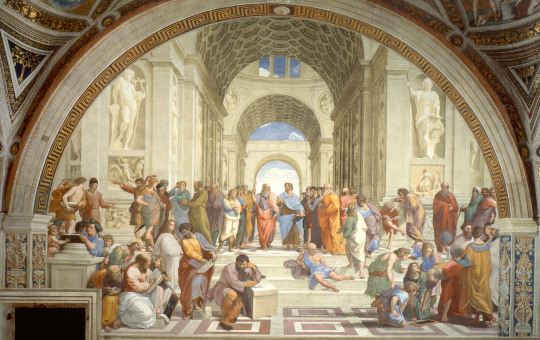
Fig 1.0 Fresco of Raphael's Scuola di Atene (The School of Athens), 1509-11 (courtesy of the Musei Vaticani).
The School of Athens by Raphael Sanzio, or more accurately, Raphael and his studio. This elaborate wall mural is a fresco in the Stanza della Segnatura, Vatican. Measuring 584 cm in length, this artwork was made in 1509 and finished in 1511.
I think that this artwork is a phenomenal masterpiece. From a technical standpoint, it is no debate that the scale and the mastery of human figures are impressive. Every single aspect is carefully planned, apparent from the detail of the backdrop to the individually distinctive figures present in the artwork. The symbolism in this work represent the core of Philosophy through subtle means of the wall division, the composition, down to the character’s body language, where they are situated, and even from the clothes they wear. In this essay, I discuss what all of the previously-stated elements mean and how they come together to give this artwork its meaning, and its significance.
Before delving into analysis of the artwork’s components, it is important to discuss why this artwork was made. This wall mural is part of Pope Julius II’s commission to decorate his private library (Zucker and Harris). The room has four sides, with each side representing the four branches of human knowledge at the time of High Renaissance: Philosophy, Divinity, Poetry, and Justice. The School of Athens, located on the east wall, represents Philosophy and is directly facing Disputa, representing Divinity (Zucker and Harris).
This placement, and the fact that this artwork is no less impressive than Disputa, can be seen as one of the defining attitudes of the High Renaissance: secularization. Here, the religiosity and philosophy are seen as equals, alongside poetry and justice. This is a big step from pre-Renaissance times when religion tended to dominate and rule above all aspects of life (qtd. in Toman iii).
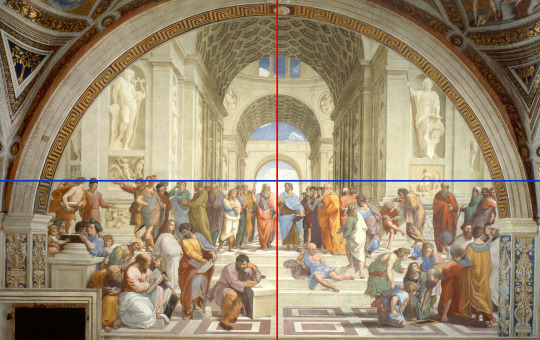
Fig 1.1 Imagined horizontal and vertical lines of The School of Athens.
Moving on to the aspects of form of the artwork itself, I will first talk about its composition. In Fig 1.1, it is shown from the horizontal blue line that “… below the vaulted architecture and celestial backdrop, [Raphael] set the assembly of philosophers in the lower half field, on earth” (Rosand). This means that Raphael deliberately separated man, who is concrete and earthly, from the abstract.
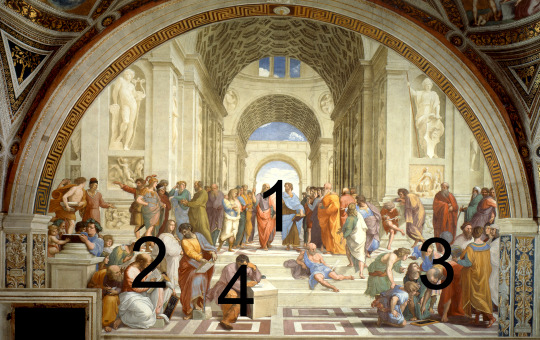
Fig 1.2 Areas of interest in The School of Athens, as labeled with numbers.
Next, the vertical red line between the two figures in the center of the artwork (Area 1 in Fig 1.2). This imagined line serves as a divider for the opposing school of thoughts in Philosophy: Plato, the older man on the left, represents the ethereal and the abstract. He represents the belief that “… there is a realm that is based on mathematics, on pure idea that is truer than the everyday world that we see” (Zucker and Harris). Whereas Aristotle, the younger man on his right, represents the belief “… on the observable, the actual, [and] the physical” (Zucker and Harris).
This divide can be seen from the other characters’ placement in the artwork. In Area 2 (Fig 1.2), which is Plato’s side, are a cluster of people who are also concerned who explains the world from an abstract, cosmic lens (Rosand). This is contrasted by the group of people (Area 3) in Aristotle’s side, who explains the world through factual and concrete means (Rosand). I shall explain how I know the aforementioned observations through analyzing the elements, aspects of form, and the identity of each figure that makes up The School of Athens.
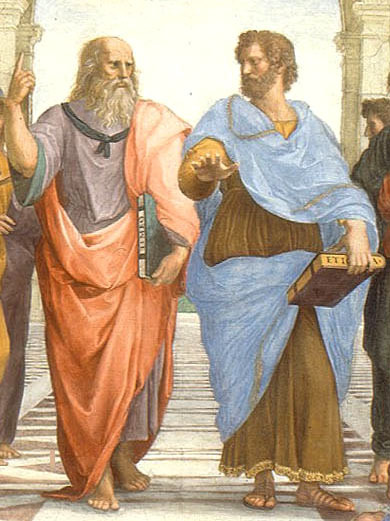
Fig 1.3 Zoom in of Plato and Aristotle.
First, the two main figures (Fig 1.3) in the center of the fresco (Area 1). They are separated from the others by the arc frame of the background. I have said before that the older man on the left is Plato, and the younger man is Aristotle, Plato’s pupil. They are also holding their own books, Plato with his Timaeus, and Aristotle with his Ethics. This section of the essay will highlight how the subject matter and design elements reflect the meaning of the divide in schools of Philosophy.
Plato, representing the ideal and the abstract, wears purple and red. “… The purple, referring to the ether, what we would call the air, [and] the red to fire, neither of which have weight” (Zucker and Harris). Whereas “Aristotle wears blue and brown, that is colors of earth and water, which have gravity [and] weight” (Zucker and Harris). This contrast between the abstract versus the concrete is further compounded by their body language: Plato, pointing up to the heavens, to the realm of high thinking, his bare feet just merely planted on the ground. Aristotle, his hand splayed downwards to the ground, wearing gilded sandals, feet firm on the tiles (Rosand).
Second, the homage to ancient antiquity, apparent in the pagan sculptures of Apollo on the top left and Athena on the right (Rosand). The design of the architecture, with coffered barrel vaults, pilasters, et cetera, is ancient Roman design as well. The god and goddess of the ancient times only reinforce the conceptual divide of the artwork, with Apollo, the god of music and poetry, things that are appropriately platonic (Rosand). Then there is Athena, the goddess of war and wisdom, who is more involved in the practical affairs of man (Zucker and Harris).
The architecture design, which is equal throughout the artwork, represents the unifier in this artwork full of divides. They serve as a reminder that even though there is a fundamental divide in perspective, all of them are still under the same branch, Philosophy (Rosand).
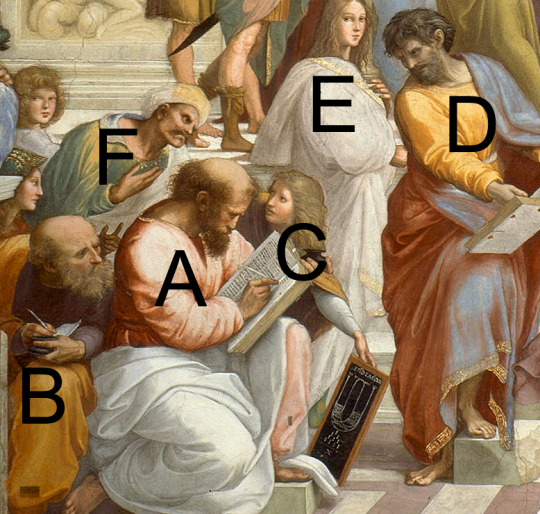
Fig 1.4 The labeling of figures in Plato’s side using capital alphabets from A to F.
Third, the groups of people on Plato’s lower side in Area 2 (Fig 1.2). These figures are labeled with letters (Fig 1.4). Though the identities of many of the figures here is much debated, since Raphael did not leave any notes or annotations, let’s agree for the sake of discussion that:
A: Pythagoras, a Greek philosopher and mathematician who is arguably in the center of this group gathering. He sought to discover the mathematical principles of reality through musical harmony and geometry (Rosand).
B: Boethius, a Greek philosopher who wrote The Consolation of Philosophy (Lahanas).
C: Anaxagoras, a Greek philosopher that correctly explains solar eclipses and the presence of small particles (atoms) in all objects (Agutie).
D: Parmenides, a Greek philosopher who founded the method of reasoned proof for assertions (Agutie).
E: Hypatia, an Alexandrian philosopher, mathematician, and astronomer. She is considered to be the most famous student in the School of Athens (Lahanas).
F: Ibn Rushd (Latin: Averroes), a Spanish-Arab philosopher who wrote commentaries on almost all of Aristotle’s writings and major works of Plato (Agutie).
All of the figures in this cluster are concerned with the cosmic, bigger-picture truths, echoing Plato’s ideals. Moreover, two figures in this cluster deserve special attention: Hypatia and Ibn Rushd. Hypatia’s placement in Plato’s side is reminiscent of Plato’s principle of women’s equality (Fakhry), in fact she is the only woman in the whole artwork. On the other hand, Ibn Rushd’s placement in Plato’s side is curious, since he is more associated with Aristotle’s works more so than that of Plato’s (Fakhry). Even so, Raphael must be commended for including a woman as an equal with men and a Muslim figure, which was seen as radical and out of line in his era.
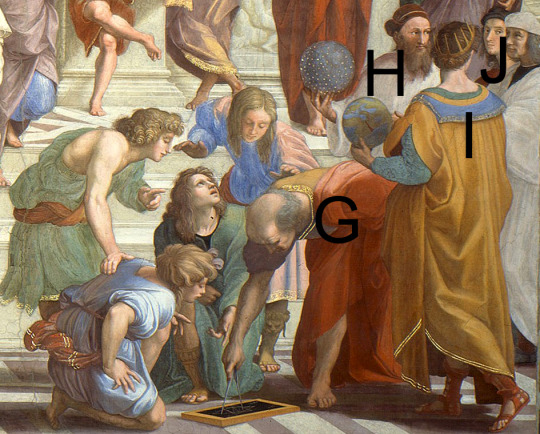
Fig 1.5 The labeling of figures in Aristotle’s side using capital alphabets from G to J.
Fourth, the group that represents Aristotle’s way of thought in Area 3 (Fig 1.2), concerned with the physical and the concrete. They are labeled with letters (Fig 1.5), with identities as follows:
G: Euclid, a Greek mathematician. He is the father of geometry and is seen bent down, applying geometry with a compass to a tablet, flat on the ground (Rosand).
H: Zoroaster, a Greek astronomer, founder of Zoroastrianism, holding a celestial orb (Agutie).
I: Ptolemy, the royal astronomer, who was the first to believe that all heavenly bodies revolve around the earth (Agutie).
J: Raphael, the artist himself in black, and his mentor in art, Sodoma, in white (Lahanas).
The figures in Aristotle’s side are arguably more interesting than Plato’s, as there is more diversity in terms of the principles that the figures represent. Of course, they are all still united in their more earthly and human-centric concerns, but the inclusion of the artist’s self-portrait is the main highlight of this area of interest. For Raphael to include himself is a historical statement, as stated by Dr. Beth Harris, “… here, the artist is considered an intellectual, on par with some [of] the greatest thinkers in history” (Zucker and Harris).

Fig 1.6 Zoom in detail of Heraclitus.
Last, but certainly not least, is the lone figure of Heraclitus (Fig 1.6), an ancient philosopher that sits and thinks alone, separated from the others (Area 4 in Fig 1.2). What makes this figure stand out is the fact that he is a deviation from the orthogonal perspective of the whole artwork. Apart from Diogenes, who is sprawled on the steps, also by himself, Heraclitus feels out of place in the artwork. This is because Heraclitus was actually added after the fresco was finished (Rosand).
At this point, I will discuss the personal aspect that Raphael weaved throughout this commission; Heraclitus’ figure is one of them. The model for this ancient philosopher is actually based off of Michelangelo, and this insertion, this acknowledgment of the older artist is very curious in of itself. The personal antipathy between them is well known; Raphael, the sociable and cultured artist was intensely disliked by Michelangelo, the brooding and melancholic artist, who accused him of stealing his ideas from the Sistine ceiling (Hale 274). For Raphael to include him in his impressive fresco can be said as an homage or a tribute to Michelangelo (Rosand). This speaks of Raphael’s respect and regard for the other artist despite their differences.
Heraclitus is not the only figure who is modeled after someone else –in fact, most of the major figures in this artwork are modeled after someone else- take, for instance, Plato who is actually modeled after Leonardo da Vinci (Toman 336), an artist that highly inspired Raphael. For him to model Plato, the central figure of his fresco and one of the greatest thinkers of all time after Leonardo is a significant honor to his person. Another instance is Euclid. The geometer is actually modeled after Bramante the architect, Raphael’s friend and professional companion (Toman 336). His tribute for Bramante doesn’t end there; the architectural design of the background is actually inspired by Bramante’s architectural design and vision (Martindale 83).
All of the analysis of the components, and how even the smallest things contribute to a greater meaning, is the main reason why I think this artwork is phenomenal. If anything is to be obvious from my essay, is the amount of planning, effort, and thoughtfulness that Raphael did for this fresco. For me, personally, there is nothing more impressive than a successful execution with an underlying concept that is well thought of in every step of the way. In this, I am very pleased with Raphael’s technical skill to make something so legible on an intimidating scale, yet still retaining a degree of thoughtfulness that is apparent in every single dot of his fresco.
To further compound this, I am not the only one who thinks that this artwork is extraordinary. The School of Athens has received high regard from the moment of its completion, even until the present day. The Stanza della Segnatura has been a famous tourist attraction because of the wall frescoes that Raphael made, and The School of Athens is arguably the main attraction in the Vatican Palace.
Most importantly, however, is Raphael’s own influence on the High Renaissance, and what follows after. As Johan Huizinga, a Dutch art historian has stated:
The Renaissance marks the rise of the individual, the awakening of a desire for beauty, a triumphal procession of joyful life, the intellectual conquest of physical realities, … a dawning of consciousness of the relationship of the individual to the natural world around him (qtd. in Toman i).
To attribute all of those values of the Renaissance to just The School of Athens is optimistic at best and naïve at worst, but it is worth acknowledging that The School of Athens is one of the main highlights of the High Renaissance, and certainly sums up the entirety of the High Renaissance. In this light, Raphael deserves much acclaim, as written by Luitpold Dussler in his book Raphael:
Raphael has left an indelible mark on art. He revolutionized portrait painting … and epitomized the style which has come to be known as High Renaissance. … Perhaps Raphael’s greatest achievement is that he appeals on all levels and makes something profoundly deep and complex appear simple and comprehensible (qtd. in Hale 275).
In conclusion, the value of Raphael’s The School of Athens is that it is invaluable. It was significant by the time it was completed, and is still significant even today, more than five hundred years later. More than just a room decoration, it speaks of the general perspective of Philosophy during the early 16th century. Raphael’s ability to condense such a difficult, multi-faceted discipline into a thoughtful work of art that can be appreciated by anyone, at any level, is a testament to his remarkable technical skill and conceptual knowledge.
I will end my essay with one conviction: that The School of Athens is one of the definitive artworks of the High Renaissance, and I hope that the significance of attributing an entire period to one single artwork is realized and acknowledged.
Works Cited
Zucker, Steven and Beth Harris. “Raphael, School of Athens.” Smarthistory. 27 Jul. 2014. 3 Nov 2017.
Toman, Rolf. Introduction. The Art of the Italian Renaissance. Germany: Könemann, 1995. Print. i, iii, 336.
Rosand, David. “Raphael’s Fresco of The School of Athens in the Stanza della Segnatura of the Vatican Palace.” Columbia University. New York. N.d. 3 Nov 2017.
Lahanas, Michael. “The School of Athens, ‘Who is Who?’ Puzzle.” Hellenica World. N. d. 3 Nov 2017 <http://www.hellenicaworld.com/Greece/Science/en/ SchoolAthens.html>.
Agutie. “Raphael (1483-1520): The School of Athens, 1509. Interactive Map.” Geometry from the Land of the Incas. 13 Jul 2014. 3 Nov 2017 <http://agutie.homestead.com/files/school_athens_map.html>.
Fakhry, Majid. Averroes (Ibn Rushd) His Life, Works and Influence. London: Oneworld Publications, 2001. N. p.
“Raphael.” Encyclopaedia of the Italian Renaissance. Ed. J. R. Hale. Lindon: Thames and Hudson,1981. Print. 274-275.
Martindale, Andrew. Man and the Renaissance. London: Paul Hamlyn Limited. 1966. Print. 83.
#raphael#the school of athens#athens#fresco#mural#renaissance#art#stanza della segnatura#vatican#city#plato#aristotle#scuola di atene#essay#analysis#heraclitus#michelangelo#philosophy#steven zucker#beth harris#rolf toman#david rosand#michael lahanas#agutie#majid fakhry#andrew martindale#italy#italian#malphigus#malphiguswrites
39 notes
·
View notes